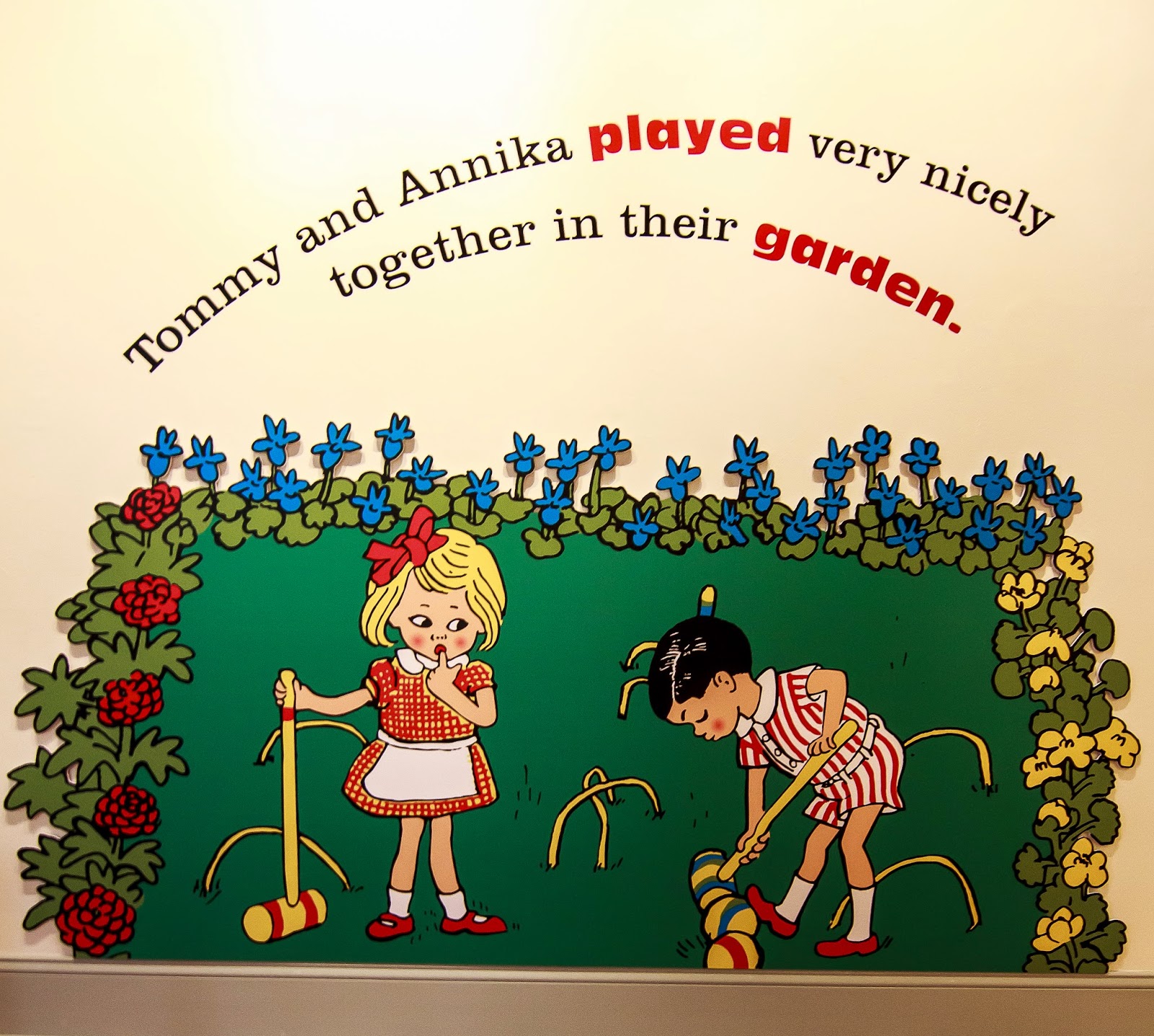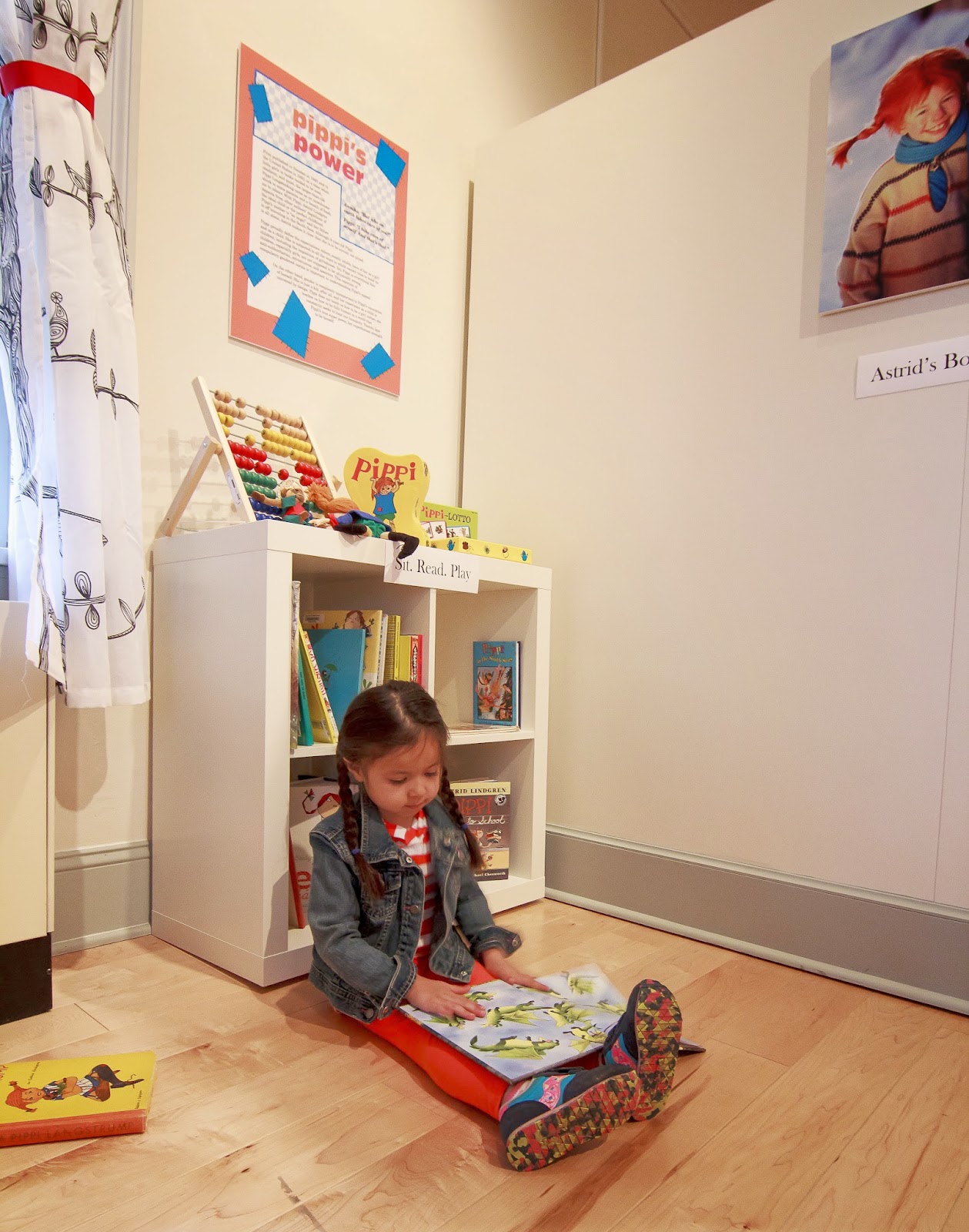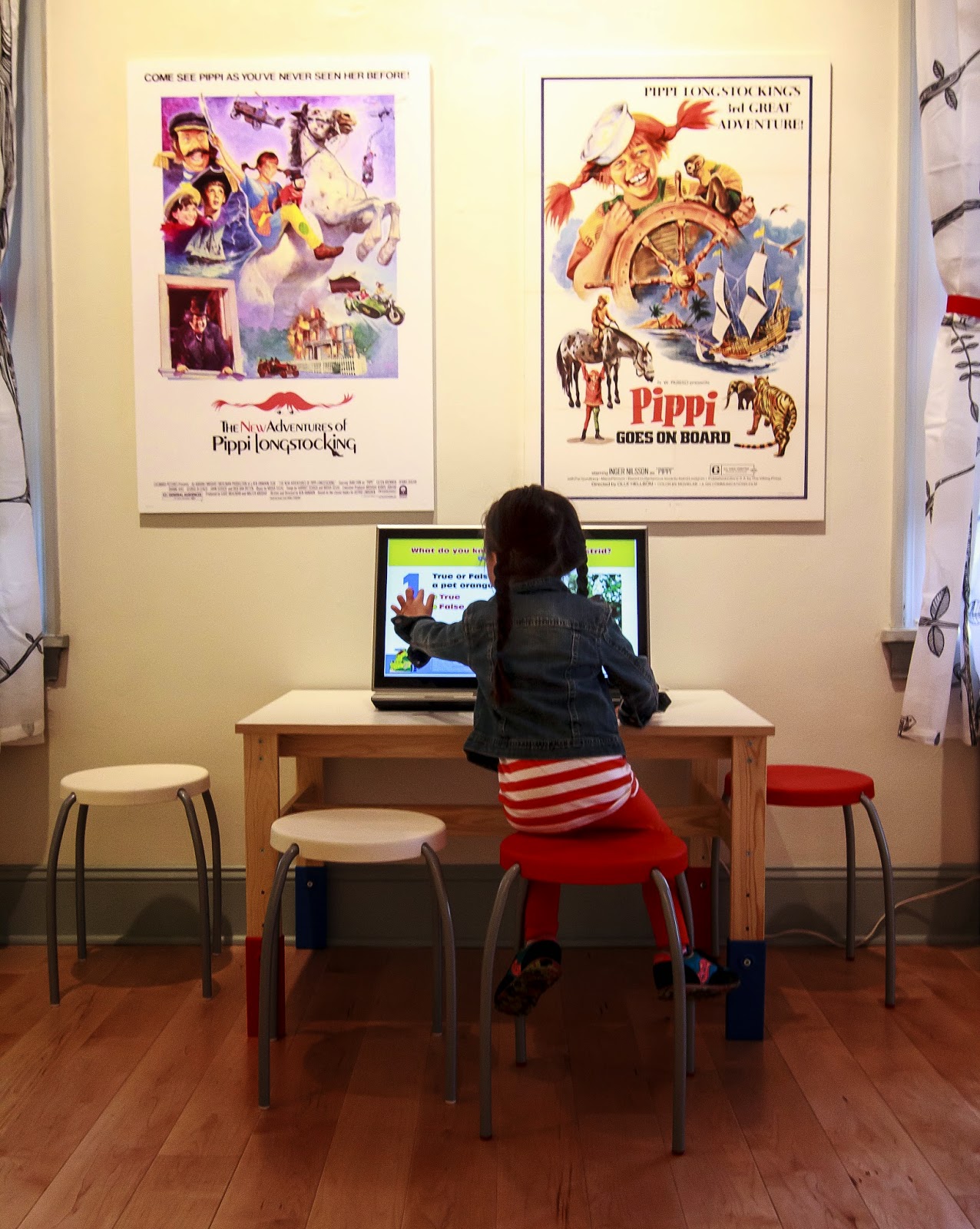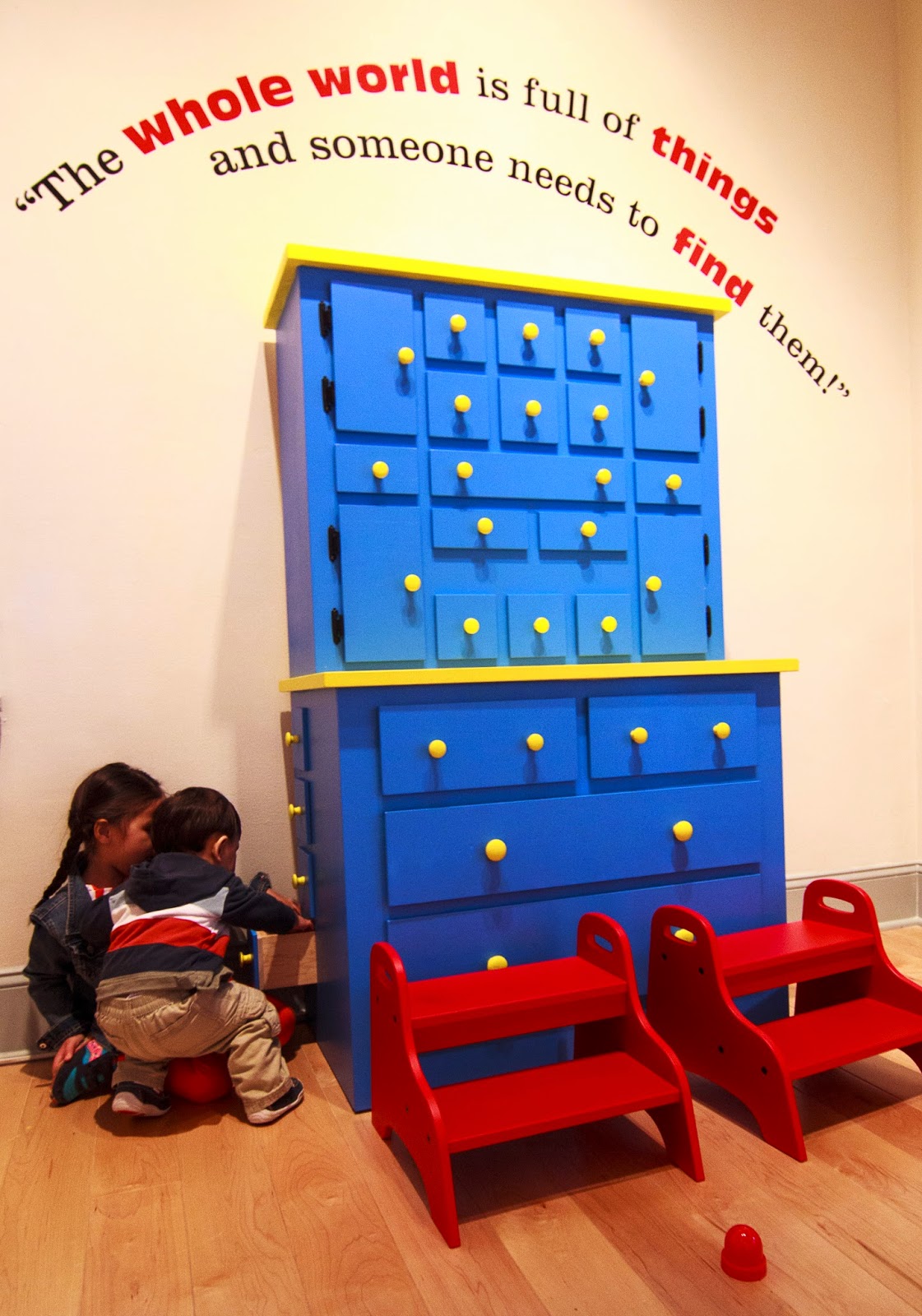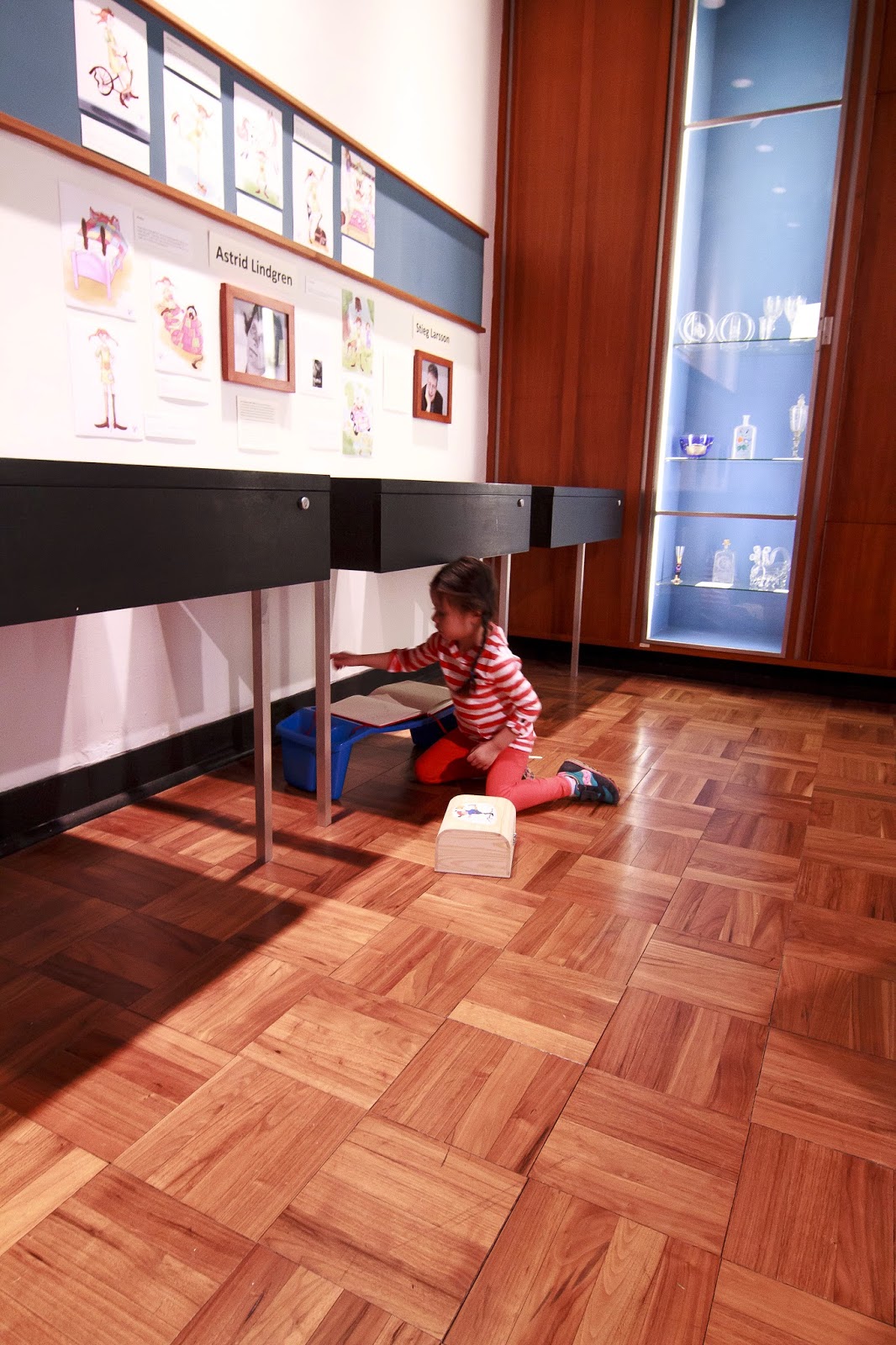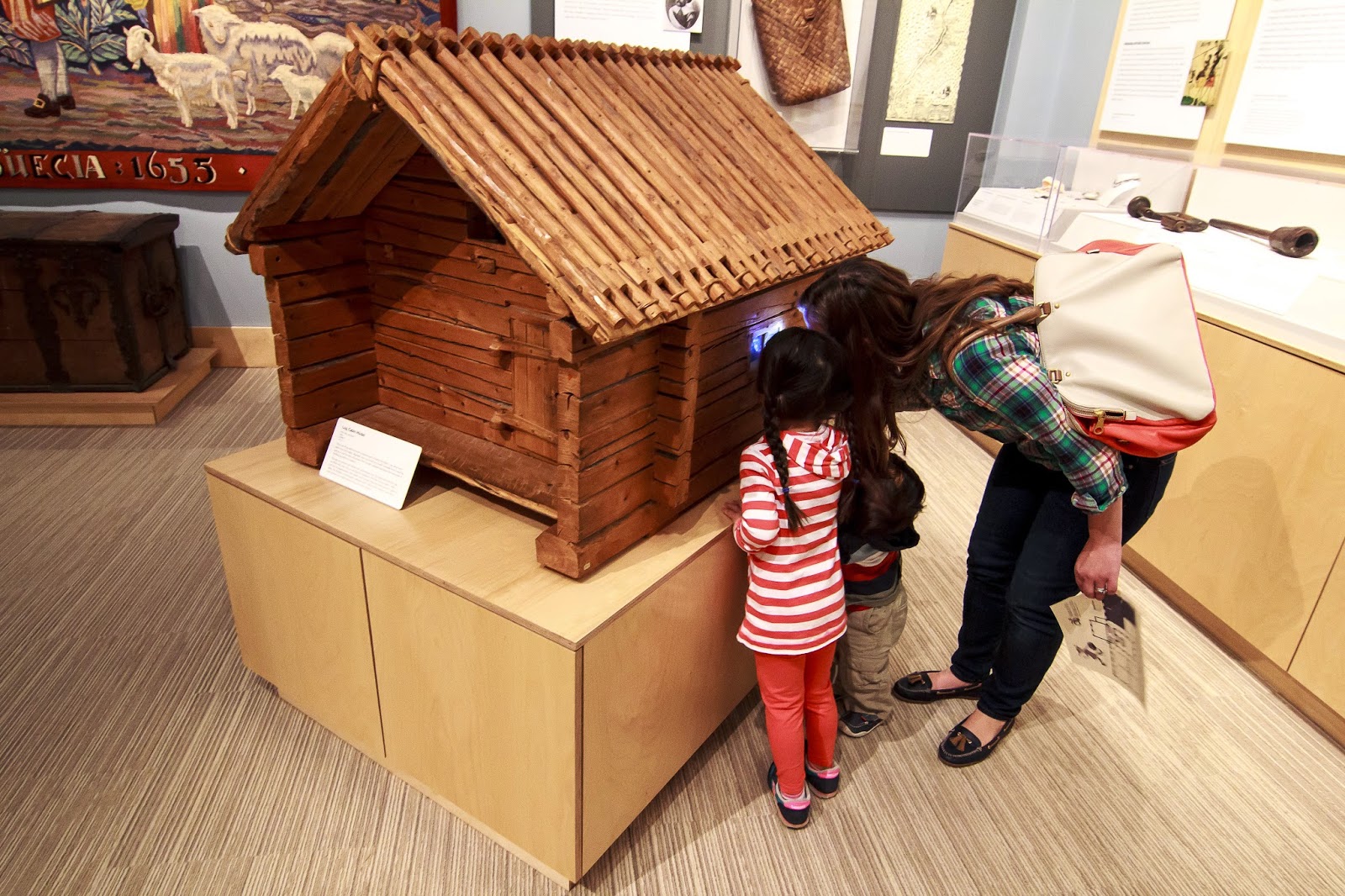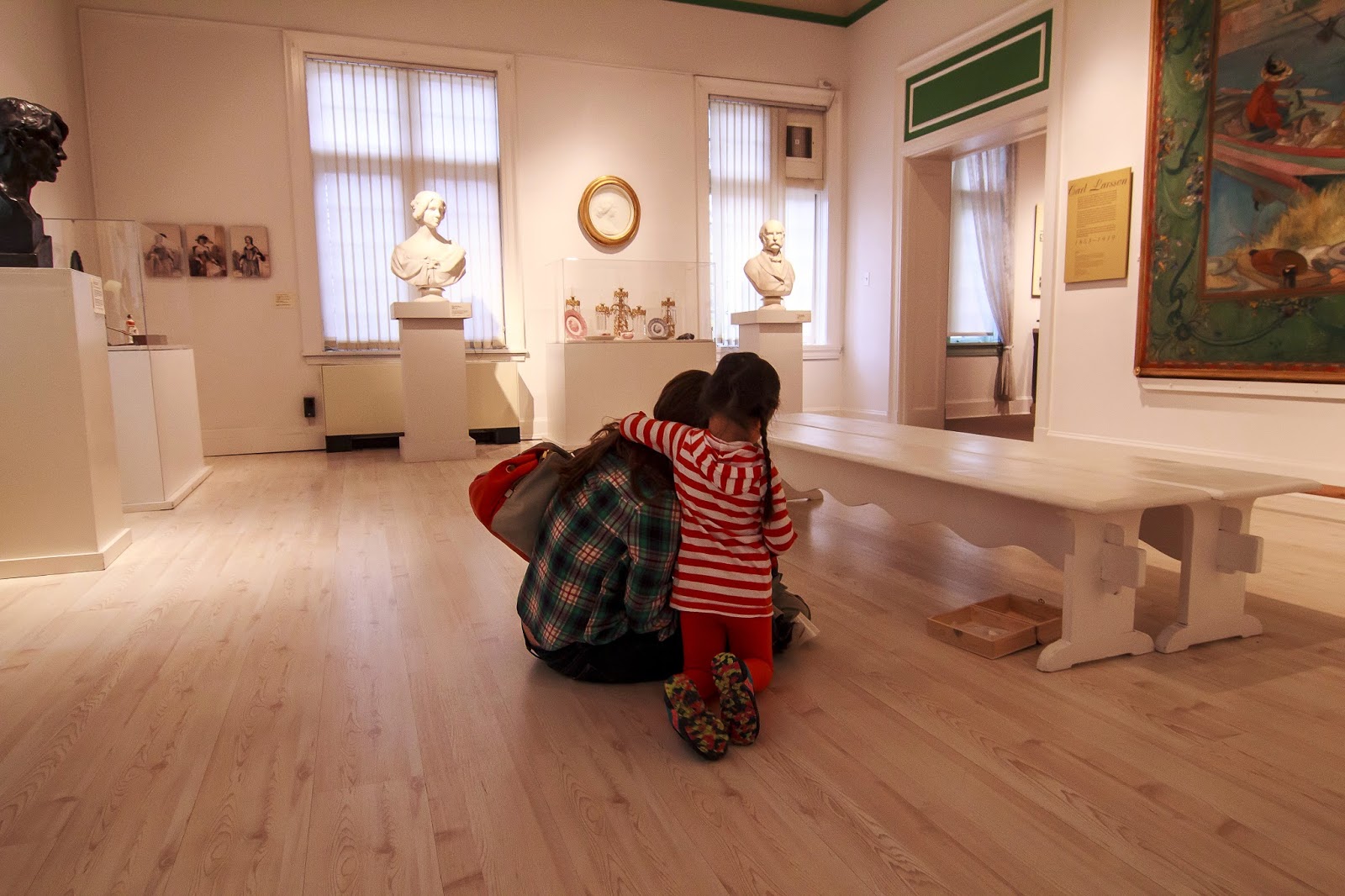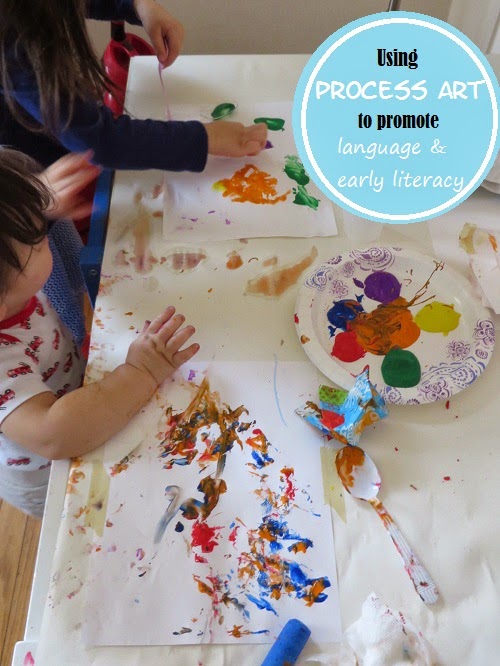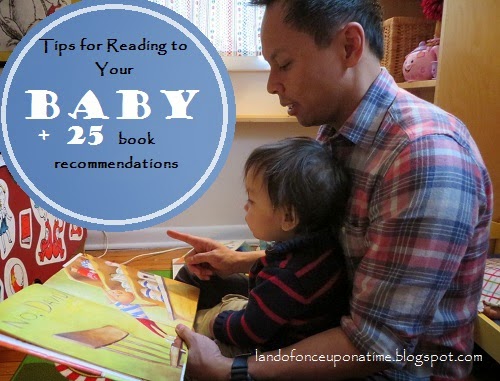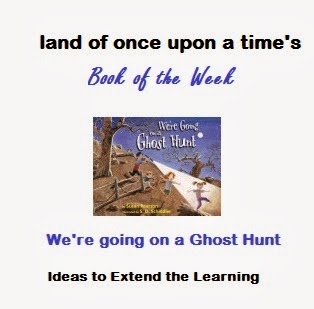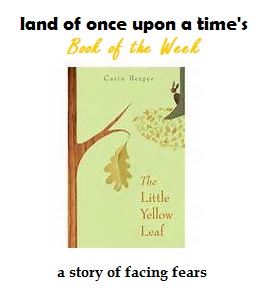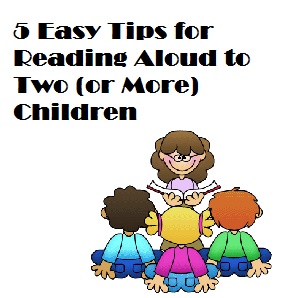new posts in all blogs
Viewing Blog: Land of Once Upon A Time, Most Recent at Top
Results 1 - 25 of 166

The tale of an educational-psychologist mom who is trying to make a difference in her child's life one book at a time.
Statistics for Land of Once Upon A Time
Number of Readers that added this blog to their MyJacketFlap:
Disclosure: We received a free copy of Carrot Saves Easter for our review, but as always my opinions are honest and I'd never promote a book we didn't enjoy!
Since becoming a mother over 5 years ago, it's been important to me to not only teach my children the ABCs and 123s, but also teach them practical skills, values, ethnic and religious heritage, and instill in them a sense of identity and belonging. Through our family's traditions, my children are not only learning all of these things, but are forming lasting memories for years to come.
What are our family traditions?
Well, each October a "Halloween Ghost" visits us for 31 days and leaves a little treat behind (yes, each day). In November we trace our hands, cut them out, and write one thing we are thankful for on the back, then hang our "leaves" on our "thankfulness tree" built out of branches we find in the yard. In the winter, we donate toys to children in need, and cut down our own tree at the local farm. At Christmastime, our Elf Sparkle brings us a Christmas book to read each day, and leaves a new version of The Night Before Christmas on Christmas Eve each year.
We have smaller traditions and rituals like having pizza every Friday night, going out for dessert on Thursday evenings, and reading exactly 3 books before bed.
A new tradition
Today I'm sharing a new book, Carrot Saves Easter, that will inspire our newest family tradition.
.jpg)
The tale of a bunny helper
The story of
Carrot Saves Easter takes place on Easter Island where a magical factory relies on kindness to help make sweet treats for little boys and girls to eat on Easter. But a problem arises when the Easter Bunny realizes the supply of good deeds is running low! A bunny helper named Carrot comes to Easter's rescue by traveling far and wide to bring stories of good deeds back to Easter Island.
Each copy of the book comes with its own bunny helper like Carrot, who reports back to the Easter Bunny all the good deeds that your child does during the Easter season. Children are encouraged to "Each night before Easter tell your bunny helper the good deeds you have done" so that Easter can be saved year after year. There is a journal in the back of the book to record all of your child's acts of kindness.
What do I love about this book?- It provides great talking points for parents and children to discuss what it means to be a kind person, perform selfless acts, and why these things are important. Discussions like these are important for receptive and expressive language development.
- It's a book that truly encourages parent and child bonding time in an age of technology
- It gives specific examples of children doing good deeds.
- It provides the opportunity for children to practice writing skills with the inclusion of the journal.
- It makes a wonderful family keepsake to look back on each year.
- It's a sturdy and well-made product! The book will withstand being a favorite and the bunny helper is high quality to withstand cuddles from any child for many years.

In addition to my being a fan of the book, my children really enjoyed reading it too. The illustrations are full of vibrant colors, and include one hidden egg on each page (which my children thoroughly enjoyed finding). This book inspired my daughter to make me breakfast in bed one morning (it was not yummy at all, but so cute), and I'm very impressed at my daughter's desire to do good deeds. My son is younger and only beginning to understand what it means to be a "good" person, but I know this book will him this year and in the future!
If you'd like to adopt your very own bunny helper and make this new Easter tradition a part of your family, books can be purchased online at
www.carrotsaveseaster.com.
Disclosure: This post contains Amazon Affiliate links. Thanks for your support.
When people find out that I have a love affair going with children's books, they often ask me: "So what's your favorite book at the moment?" or "What do you read to your children at bedtime?" or "What books do you recommend?" These are questions that parents and grandparents and nannies and teachers are always curious about - everybody seems to be looking for a new great book to read!
Today I'm sharing 10 great books to read aloud. I read these books often with my children, and these are books that we all love and can read again and again. Some of these books may be familiar to you, some may be unknown - but if you haven't read them aloud with your child yet, you should!
1. Alexander and the Terrible, Horrible, No Good, Very Bad Day by Judith Viorst and illustrated by Ray Cruz


As a child I loved hearing this story, and as an adult I love to read it to my children even more. Everyone can relate to having a "terrible, horrible, no good, very bad day". It's a great book to read aloud because Alexander's voice and attitude are expressed so clearly in the way Viorst writes that you can make the character "come alive" as you read it. And while I have seen this book criticized, I really couldn't love it any less, no matter what some say about Alexander being bratty and spoiled. It's a perfect book to open up a conversation with your child about having a day that's just not going his way.
2. Veggies with Wedgies by Todd H. Doodler


You might know author Todd H. Doodler from another underwear-themed tale,
Bear in Underwear. This story about a bunch of veggies who happen upon a bunch of underpants hanging out to dry is....well, pretty funny. There are lots of veggie characters in this book and when I read it with my children, I give each one its own distinctive voice. I promise this book will make you and your kids chuckle, or at the very least smile.
Veggies with Wedgies would be a great book to buy for a potty-training toddler or preschooler - it will not only get them excited about underwear, but will put some silliness into what can sometimes be a less than fun transition.
3. Where the Sidewalk Ends by Shel Silverstein


In my humble opinion Shel Silverstein is a genius. I've read this collection of poems over and over and over again and never tire of it. My children can recite some of the poems by heart because many are short, and I'd imagine can keep the attention of even the busiest of toddlers. All of the poems in this collection are what I would call "whimsical". Some are touching. Some are just outright hysterical and goofy. Basically what I'm saying is that this book of poems has something for everyone. And, did you know that rhymes like these aid in your child's pre-reading skills by drawing his attention to the different sounds in spoken words? Yep, you should really pick up this book if have never read it, and your child's preschool teacher will thank you. Oh, and Silverstein's drawings are just as genius as his words.
4. Blue 2 by David A Carter


Blue 2 is really an art book to me. There aren't many words, but the words that Carter uses in this intelligently crafted pop-up book will give your child a lesson in vocabulary. I put this book on my "read aloud" love list because it's something fun to read
and do with your child. If you ask my daughter what her favorite present was this past Christmas, she'll definitely respond,
"Blue 2". Trust me, you will read this book over and over again - not always because you want to, but because you just HAVE to find all of those hidden Blue 2's!
5. Brief Thief by Michael Escoffier and illustrated by Kris Di Giacomo


I do have to warn you that this book does contain potty humor, but the giggles I get from reading it make me happy. Brief Thief does have a very important lesson to be learned too: don't touch other people's things. My children just love to read this book over and over for a plain and simple reason: it's fun. And in my mind, if you can take a valuable lesson and make it fun to learn, it's a win win for all.
6. Rosie Revere, Engineer by Andrea Beaty and illustrated by David Roberts


This book gets one thing right with its title - this world needs more female engineers! I'm loving this book not only because it's inspiring to little minds, but it gives you a great feeling when you are done reading it. You can't help but feel like you did at least one thing "right" in the day by reading it with your child.
7. Eric!...The Hero? by Chris Wormell


Ah, Eric! The boy that nobody believes in, and who seems to be good at nothing. I think we all can relate to feeling a little lost and misunderstood at times which is why I love this book. Wormell's story is about courage, finding yourself, and believing in your own abilities, even when no one else does. This book is especially great for kids who love monster books, and parents (like me) who love to teach important life lessons through books.
8. The Gruffalo by Julia Donaldson


My kids adore this book, and I do too because it's clever. The first time I read it I remember thinking - well, isn't that an adorable ending to a perfectly enjoyable book.
The Gruffalo is fun to read aloud because you can really put a lot of expression into the character's voices, and even give the story an eerie feel in the way that you read it. In my opinion, this is one of those great children's books that you can cuddle under a blanket and read together....and anticipate exactly what's going to happen next. This book is truly a greatly told story.
9. The Girl Who Wouldn't Brush Her Hair by Kate Bernheimer and Jake Parker


A story of a little girl who wouldn't brush her hair...and you know what happens to her? She has a little village of mice who take up residence in her over-tangled locks! There are many days that I think this book was written specifically about my daughter (she even has the same long brown hair). We love this story because it takes something that we struggle with on a daily basis and exaggerates it. I'm sure many families with little girls can relate. And of course, if you think a book was written
for you and
about you...you're going to want to read it aloud again and again like we do.
10. Tap to Play by Salina Yoon


A truly interactive book where you play a game as you read along! My 5-year old and 2-year old equally love reading this with me and the second we are through, ask to read it again. While
Tap to Play reads like a traditional book, it feels like an iPad app with all of the fun, and none of the screen-time guilt (which I sometimes feel, anyway). I have no doubt this book will become one of your household favorites to read (and play) over and over, like it is ours.
So there you have it....my book love list (just in time for Valentine's Day). Of course, if you ask me in a week, I might have some new favs to add to the list, but as of right now these books get my votes and I'm sticking to it.
What are your favorite books to read aloud lately?
Disclosure: We received a copy of Prima Princessa's The Nutcracker for review, but my opinions expressed are honest, as always!
If you ask my daughter what she wants to be when she grows up, she'll emphatically say a dancer and a singer. She likes to perform, sing show tunes, and dance to Let it Go. I'm happy to add to this list that she is mesmerized by the Nutcracker, thanks to Prima Princessa's adorable (not to mention educational) Nutcracker DVD.
What I loved about Prima Princessa's version of the Nutcracker is that it combines live performance with interactive ballet instruction. Designed especially for a 3 - 6 year old budding ballerina, the 60 minute DVD lets children enjoy the Nutcracker as performed by England's Birmingham Royal Ballet, while a cartoon "Prima Princessa" narrates. Following clips from the live performance, the DVD invites children to dance along by demonstrating several ballet steps.
Other great things about this DVD:
- It gets kids moving! Physical activity is very important for learning.
- Children learn by doing with Prima Princessa. Rather than just watching a dancer twirl, they can get up and twirl along.
- It's educational - children learn real steps and real ballet terminology.
- It explains the plot of the Nutcracker in a kid-friendly way, with a narrator that appeals to young children.
- The technical dance moves are repeated in the DVD, allowing children the opportunity to practice and master these steps.
- It's fun! Children will enjoy role playing, dressing up like a ballerina, and pretending to be a star.
My daughter absolutely LOVED this DVD and we have watched it numerous times since receiving it. It's honestly a lovely way to spend an afternoon! Here's the proof:
Prima Princessa Presents the Nutcracker is available on
Amazon.
Pairing the DVD with their
Ballet for Beginners book would make the perfect gift your little ballerina this holiday season!
Disclosure: We received a free Story Starters game from Mama May i for this post, but my opinions are honest, as always!
While my children and I have spent countless hours reading aloud together, the stories we have created on our own are far and few between. Storytelling games, like Mama May i's Story Starters, are a fun literacy enriching experience for young children that are a great supplement to reading aloud. Through these games, children craft unique stories that stretch their creativity and empower their imagination as they take on roles as a story listener, a story teller, and a story writer.
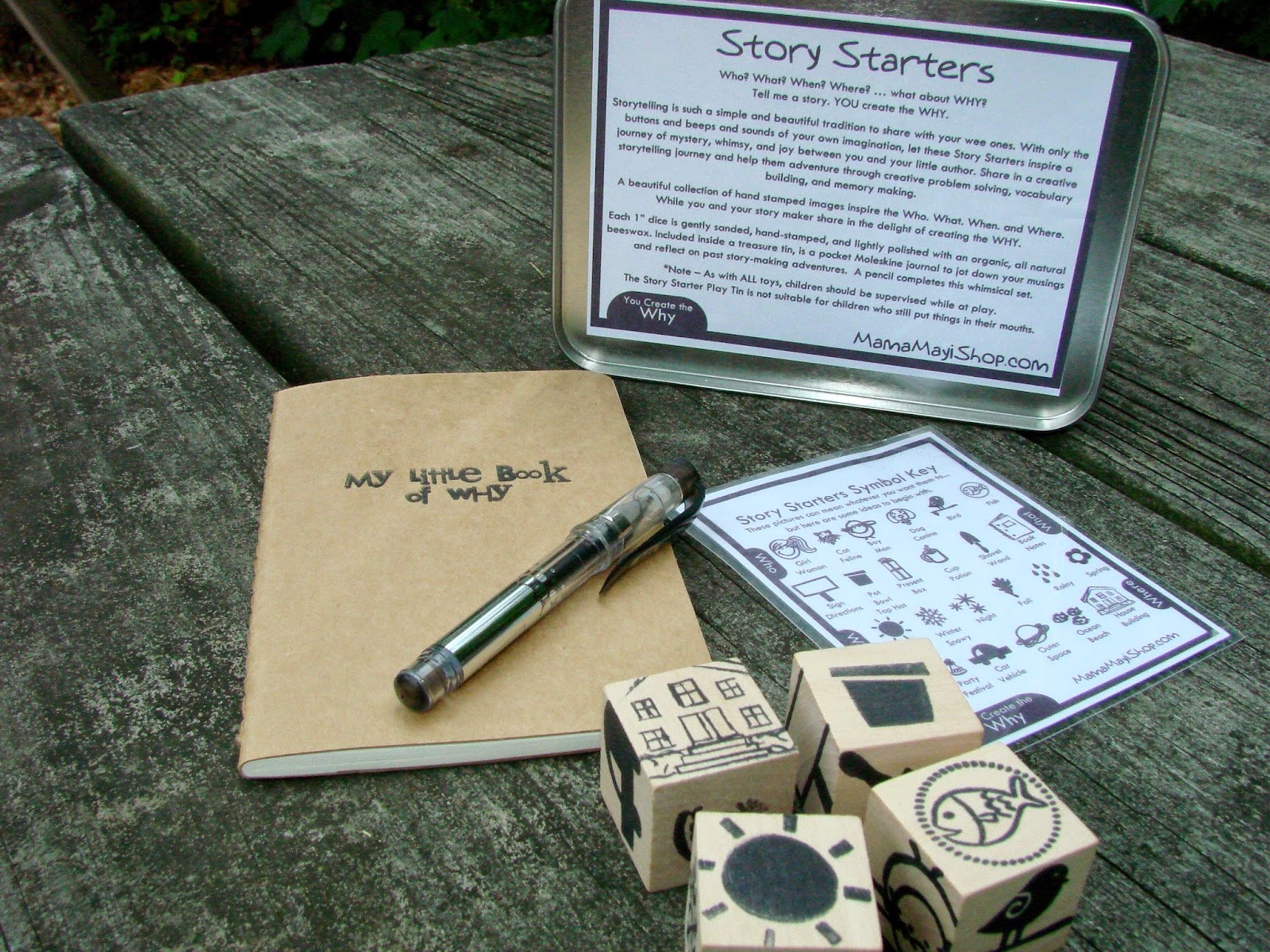
Mama May i's storytelling game is a handmade learning toy that arrives in a shiny tin, complete with 4 story starter dice, a symbol key, a little book of why, and a pen. For group play, the youngest player rolls the cube and begins the story with the image that lands face up. Then the next player rolls and adds to the story. To play alone, you simply roll the dice and let your imagination run wild based on the pictures you see! The dice help you with the who, what, when, and where but the why is up to the players to create. To help you remember your stories, you can write or draw them in the journal provided.
If you are like us and enjoy reading and learning - you might want to invest in Mama May i's story starters as an additional literacy activity (you know, for when you've read that same book 1,000 times in a row and just can't stand to make it 1,001). Plus, storytelling games offer lots of educational experiences, in addition to being just plain fun!
Here's some benefits of storytelling play:- It fosters creative thinking - "you create the why".
- It enriches your child's imagination because he'll be forming mental images as the story is being told.
- It strengthens reading and writing skills.
- It teaches elements of a story - who, what, when, where; beginning, middle, end; plot; conflict; theme.
- For children who are reluctant to read aloud with their parents, storytelling can provide a different kind of shared literacy experience.
- It aids in emotional development as the characters in the stories partake in various adventures; children identify with the way a character responds in various situations.
- It teaches new vocabulary.
- It promotes listening and speaking skills.
- It promotes teamwork and turn taking.
- Last but not least, it creates memorable experiences!
What did my kids think of their new game?They loved it, of course! My 4-year imagined a story around a boy named Will who was given a magical shovel that could pick up leaves on its own, and my 22 month old enjoyed naming all of the pictures and making up some shorter stories.
What did I think of the new game?I thought it was an easy way to play a game together (without having to read a million rules, which I despise), have some fun and be silly, and sneak in something educational that didn't
feel educational. I also loved the personal note from Jessica Perkins, the founder and designer of Mama May i, that came in the game's adorable packaging. The fact that it's all non-toxic is a bonus too, considering I still have a toddler who likes to put things in his mouth.
Interested?You can order this game as well as other educational, handmade toys inspired by Montessori and Waldorf methodologies from
Mama May i. As a fellow Philadelphian, I just adore the
Make a Match Game with Philly sites.
You can also follow Mama May i on
Facebook and
Twitter. If you order from Mama May i before the end of November, use the code LANDOFONCEUPONATIME at checkout for $5 off a purchase of $30 or more.
Enjoy making learning fun!
Disclosure: This post contains Amazon Affiliate Links.
I love narrative books. There's something about them that's so appealing because they often provide a nice escape from reality or an exciting adventure. I have no doubt that my children who are 4 1/2 and 20 months feel the same. So often we go to the library and come home with a stack of imaginative picture books. You'll see this blog is full of these types of stories. More often than not, the non-fiction and informational picture books can get left behind at the library!
There are really REALLY great reasons, though, to embrace (and yes, check out) books that are packed with information for children.
Here are 5 benefits of reading non-fiction and informational picture books with your young child.
- Children may gain interest in a new subject area, which drives them to learn (and read) about the topic even more.
- Opportunities for learning new vocabulary are plentiful (which is a great thing, since vocabulary knowledge has been linked to success in Kindergarten).
- Non-fiction and informational picture books can ignite curiosity in children and lead them to ask "why" questions.
- These books can provide a basis for hands-on learning activities (which is one of the best ways to learn about a topic).
- Often these books initiate more conversation than narrative stories, building language and comprehension skills.
Convinced you should check out some non-fiction and informational picture books on your next trip to the library? Take a look at these fall-inspired informational children's books!
Learn the names of plants and animals, and of course - some fun facts about squirrels. The blog Ready-Set-Read has several neat ways to extend the learning with this book in this
post.

Learn all about growth, gardening, and the life cycle from seed to pumpkin. Check out this sequencing activity to accompany this book.
Red Leaf, Yellow Leaf by Lois Ehlert


This book is packed full of information about trees, birds, and gardening. Learn new science related vocabulary, and even practice several math concepts with these activities inspired by Red Leaf, Yellow Leaf.


Learn about the life cycle of an apple tree, then try one of these cute apple crafts!
Do you have any books to add to the list?
My 4 year old and I had the pleasure of learning together in a unique way this past weekend, thanks to Two Ducks Theatre Company's original play titled Rainbowtown.
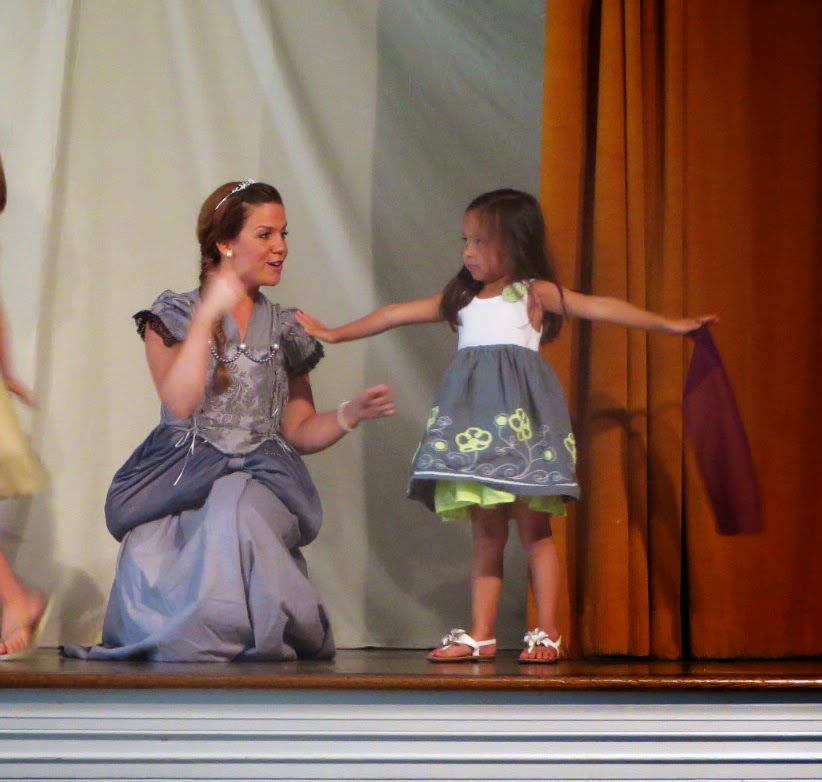
The plot of
Rainbowtown focuses around Queen Annie who lives in "graytown" where everything is "fine". But, she wants life to be a little more than
just fine, so she sets off in search of a new place to call home. As she travels from town to town looking for her new residence, children are taken on a colorful, interactive journey that includes music, audience participation, and lots of laughs.
Where does Queen Annie decide to build her castle? Experience the fun yourself to find out!
.JPG)
.JPG)
You can catch a performance of
Rainbowntown at Radnor United Methodist Church in Bryn Mawr:
What's the real value of Rainbowntown?
At at the heart of the play is a lesson for children on emotions and perseverance - two important topics in early childhood.
Talking about feelings with children is important to their social and emotional development. By doing so, children can better understand and interpret their own feelings and the feelings of others. Children with emotional competence also tend to have strong social skills which are necessary for successfully interacting with adults and peers.
Rainbowtown provides a unique opportunity for families to begin a discussion about feelings which can strengthen skills in children that are not only necessary for learning new information, but for succeeding in life.
Rainbowtown also teaches children skills about how react in the face of adversity. Despite becoming discouraged after visiting a few towns that do not suit her liking, Queen Annie never gives up until she finds the place that is best for her to build her castle. Children may identify with her situation and reflect on how she copes and perseveres. By helping children learn how to react in difficult situations, parents can foster emotional skills, namely resilience.
Learning Tips and Activity Extensions for Rainbowtown
It's always fun to discuss a movie or a play after you view it. Here are some conversation starters and activities based on
Rainbowtown for promoting emotional development in young children.
- How did Queen Annie feel at the beginning of the play?
- How did Queen Annie feel at the end of the play, and why?
- Can you describe a time when you felt like Queen Annie?
- Which characters in the story did you like or dislike, and why?
- Have you ever given up on something you've tried to do? Why? How did it make you feel?
- Identify all of the colors and feelings in the play. Why do you think a particular color was paired with a certain feeling? Would you add any colors or feelings to the story?
- Draw a picture of a time when you showed determination and perseverance like Queen Annie.
- Queen Annie was upset in parts of the play. What would you have said to her to help her feel better?
- Identify and discuss what traits Queen Annie possessed that allowed her to persevere.
- Read a book with your child about feelings such as My Many Colored Days by Dr Seuss or The Way I Feel by Janan Cain
I hope you get the opportunity to enjoy Two Ducks Theatre Company's
Rainbowtown with your child in the coming weeks, and take advantage of the play as not only pure entertainment, but also a cool learning experience!
Disclosure: This post contains Amazon Affiliate links.
We've noticed lots of school buses on the streets of our town this week! While my two little ones are still too small to ride the big yellow bus to school this year, we had lots of fun learning with a school bus book and craft.
The Bus for Us Gus by Suzanne Bloom is one of those books that your child will want to read again, and again, and AGAIN (trust me on this one). While the text follows a predictable repetitive pattern, the pictures allow the child to guess what comes next. My little 20 month old just loves to turn the pages to see if the little girl Tess is ready to hop on the bus. There's also a certain silliness to this book when the page is turned and it's not the school bus, but a different vehicle. My son just loves to shout, "No Tess!" and laugh.
School Bus Craft
We paired this book a super simple school bus craft that only uses construction paper and glue! Here's what to do to create your own at home.
1. Gather materials: yellow, black & orange construction paper; glue stick
2. Cut the yellow paper into a shape of a school bus
3. Cut the black paper into 2 circles, 1 rectangle, 4 squares, and 1 triangle
4. Cut the orange paper into 1 small circle, and two rectangles
5. Glue the shapes on to the school bus outline
(note: you could add a red octagon for the stop sign, too)
Easy.
Great way to practice colors, shapes, and counting, too!
Don't have
The Bus for Us Gus? Try pairing this craft with
School Bus by Donald Crews. It's also great for little minds.
Disclosure: This post contains Amazon Affiliate links.
Some children can't wait for the first day of school to begin, while other young children have a more difficult time making the transition from summer to "back to school". Today I'm sharing some simple books with a school theme that are especially appropriate for very young children (infants, twos, and threes). The simplicity of these texts, along with their vibrant pictures, allows for a great opportunity to discuss what your child might expect in school - whether it's his first time in a new school or are a returning student.
Books About School: Top Picks for Young Children
All of these books can help young children understand the ins and outs of the school day routine. What is also so great is that they are easy to read with very young children who might be in a day care setting, but are interesting enough for preschool students who might be returning to school after a summer break.
Click on the picture or link to find out more information on Amazon.
My First Day of Nursery Schoolby Becky Edwards and illustrated by Anthony Flintoft
Bloomsbury USA (2004)


by Robert Neubecker
Hyperion Book reprinted (2011)


We Love School by Marilyn Janovitz
NorthSouth Books (2007)


by Lucy Cousins
Candlewick (2010)

 Let's Go to School
Let's Go to Schoolby Fisher Price (TM); Doris Tomaselli
Reader's Digest (2009)

-----------------------------------------------------------------
Tips for reading these books to your child:-----------------------------------------------------------------
- Point out how your child's school will be similar to or different from the classroom's in these books.
- Talk about how the characters are feeling in the books. Relate these feelings to how your child is feeling about going to school.
- Use the books to help you describe to your child the types of activities that she will do in school.
- Identify behaviors in the books that are expected of children who are in school.
- Observe any friendships between characters in these books, and talk about making new friends.
By reading these books with your child and using these read aloud tips before you snap that "FIRST DAY OF" picture, you are giving them a head start on being ready to learn. I hope these books are a wonderful beginning to your child's school year!
What books do you read before school begins?
Reading to an active little toddler requires a certain skill set. Today my post is for parents who feel like it's impossible to get their child to sit down to read for even a second.
If your toddler is anything like mine, he's climbing on the tables and chairs, throwing balls (or sometimes less gentle objects like blocks), and coloring in places he's not supposed to. One second he wants up. The next second he wants down....and what he definitely doesn't want is to sit still.
So reading a story together? That takes actual effort! On my part, and his.
What can you do when your toddler is more interested in climbing the coffee table and throwing books, than reading them on your lap?
Here are my best tips for reading with that busy toddler that I have found to work well. Follow these suggestions and I bet you'll begin to connect in ways that make reading more enjoyable for the both of you.
- Do an activity or craft before you read together to spark interest in the story. Make connections from your activity while you are reading for additional learning and repetition of concepts.
- Make reading aloud a more fun experience. Your child doesn't want to sit still? Then don't! Act out the story, use puppets, sing the words, or play games while you read. The bonus of this technique is that your toddler will be motivated to read again.
- Let your child take the lead. Allow him to select a book that is interesting to him. If he seems more interested in the pictures than listening to the story, take a picture walk through the book instead of reading the words.
- Take advantage of meal times when your child is likely to be strapped in his high chair. Sneak in a story before, during, or after his meal. Reading while eating is better than flipping on that TV!
- Read before bed when your toddler is likely to be “played out”. There is evidence to show that bedtime routines that include stories aid in language development.
- Did your little one “read” a book all by himself? Initiate reading on his own? Recognize a job well done. Give your child praise when appropriate which will help him associate accomplishment with the act of reading.
- Select books that connect to something going on in your life at the time. For example, if you are taking a vacation to the beach, read books about the ocean or sea animals. If the story is relevant, he'll more likely be interested in it.
- Get rid of the idea of what a read aloud "should" look like. It's wonderful if your child sits in your lap while you read like you see in all of your Pinterest pins. Life isn't always ideal though. Read aloud while your child is playing. Even if it seems like he's not listening, he might be more than you think. He might even surprise you and wander over into your lap as you read, creating that picture perfect moment.
- Read the same story over and over. If your toddler has a favorite book that he actually CAN sit still to listen to 100 times in a row - that's OK! Children learn through repetition. In this post, I share ways to keep the learning going, even when it's the 100th read through!
There will be good days, there will be bad days but aim for 20 minutes EACH DAY.
You will be so delighted you put forth the effort!
The adorable red-headed rebel with the braids, Pippi Longstocking, is visiting the American Swedish Historical Museum in South Philadelphia!
A special
"Do You Know Pippi Longstocking?"exhibit is now on display through February 16th, 2015. Children can learn all about Pippi and her author-creator Astrid Lindgren in an interactive environment that is not only educational, but loads of fun too.
We had the pleasure of visiting this museum and the exhibit for the first time a few weeks ago. It is an understatement to say that my children enjoyed it! The exhibit is full of bright colors that enchanted my little toddler, as well as imaginative play that engaged my preschooler.
Our fun family outing to the museum began with an impressive entrance. As we made our way into the Pippi exhibit we were in awe of the artwork, information, and child-centric learning activities!
Here's a glimpse of what we got to explore in the Pippi exhibit:
Pippi is one strong little girl! We got an opportunity to show off our own strength with this neat contraption that is rigged to allow you to lift Pippi's horse high in the air over your head. My daughter thought this "game" was really cool.
At the center of the exhibit is a playhouse version of Pippi's home known as Villa Villekula. We spent a long time role playing and cooking up a nice meal of fried fish, veggies, and cakes for dessert. There's also a fun "guess the smell" game included.
A Pippi Longstocking exhibit wouldn't be complete without some of her beloved books! We took a few moments to relax in the book nook, meet the character, and delight in all of the different illustrations.
This quiz was the perfect way for us to learn about Pippi! We didn't know much about her before visiting the exhibit, but learned lots thanks to fun activities such as this one.
We got a little silly in the dress up area, which included lots of options to pretend to be someone or something else!
"The whole world is full of things and someone needs to find them!" I think the biggest hit of the museum's Pippi exhibit for my kids was this chest of drawers. We discovered unique trinkets and displays and even toys behind the doors. I loved how this activity really spiked their curiosity!
As you exit the Pippi exhibit to enter the rest of the museum, you'll find a map and invitation to complete Pippi's treasure hunt in each of the rooms! My preschooler was so excited to search for the small wooden box in each room, open it, complete the "game" and take a collection card. Once she collected all 10 cards throughout the museum - she turned them in at the front desk in return for Pippi's treasure. This activity allowed my husband and I to enjoy the rest of the museum, while at the same time making it fun for the kids.
The Pippi exhibit truly is fun for the whole family. It was a lovely way to spend the day learning and playing together. I sincerely wish we could have brought the playhouse home with us (that was my favorite part of the exhibit), but I guess we'll have to visit again soon.
Please visit the
American Swedish Historical Museum website for more information about pricing, hours of operation, to become a member, or to read more about Pippi, Astrid, and this amazing
exhibit!Disclosure: We received free admission to the museum in return for this post. But, my opinions are honest, and our fun and learning was real!
Death is never an easy topic to discuss with a child. Children's books can provide a helpful way for parents to explain this difficult topic. Whether you have experienced a death of a pet, family member, or friend; or just feel that it's the appropriate time to discuss this topic with your child - these book I'm sharing today can allow you to approach this sensitive subject in a kid-friendly way.
Disclosure: This post contains Amazon Affiliate links. The Invisible String by Patrice Karst and illustrated by Geoff Stevenson
The Invisible String by Patrice Karst and illustrated by Geoff Stevenson is a book that I'm especially fond of because it deals with the
fear of being separated from loved ones. When the topic of death comes up, it's easy for children to become fearful and anxious of losing those people closest to them in life.
The Invisible String, while not explicitly a book about death, teaches children that they are never truly alone and that they are always connected to those who love them. This book can offer reassurance and comfort to children facing difficult times or feelings.
Nana Upstairs & Nana Downstairs by Tomie dePaola is the true life story of this famous author's death of his own great-grandmother and grandmother. This book can help children understand how people grow old and eventually die. Children may also identify with Tommy's feelings and experience as he deals with the loss of two close loved ones in his life.


Other recommendations for children's books on death:
Lifetimes: The Beautiful Way to Explain Death to ChildrenEverett Anderson's GoodbyeWhat Happens When Someone Dies? A Kid's Book about Death and Funerals
In loving Memory
This post is dedicated to my own Nana and my children's great-Nana who would have celebrated her birthday today.
Teaching young children about colors can be fun if you get creative! Today I'm sharing a cute bunny-themed book of colors, plus 6 easy color activities for kids.
Follow bunny along the garden path as she discovers a rainbow of flowers. Since the text is written in rhyme, you can even prompt your child to guess the next color before you turn the page. With its vibrant illustrations and adorable character, babies and toddlers will enjoy learning from this book.
Be sure to follow up this story with one of these super simple color activities.
Repetition is one of the best ways for young children to learn new concepts, and presenting new concepts in different ways and in different contexts helps with the transfer of knowledge
from one situation to another.
6 easy color activities for kids
1. Play "I Spy" with colors. "I spy something blue."
2. Sing a song about colors. "Spaghetti sauce is red, spaghetti sauce is red...I can think of lots of things that are the color red." Then try other objects and colors.
3. Do the laundry. Sort the items by color {this is a great math skill builder too}.
4. Take a walk outside. Ask your child, "What do you see?" If he says "tree" - expand on that and respond, "Yes, a tree with green leaves and a brown trunk."
5. Create. Draw pictures with crayons, markers, or finger paints and name the colors as you go along.
6. Get moving. Play a game of tag by asking your child to run (or gallop, skip, or tip toe) to something of a particular color. Once they find and tag it, move on to another color.
If you are interested in trying a color mixing activity, check out this
post.
A “literacy-rich environment” is one that provides children with easy access to interact with a variety of printed and writing materials. These materials may include such things as books, magazines, crayons, paper, signs, pencils, or word labels. Having a literacy-rich home brings your child one step closer to becoming ready to read! Today I'm sharing a quick checklist of features of a literacy-rich environment that can help you to evaluate your own home.
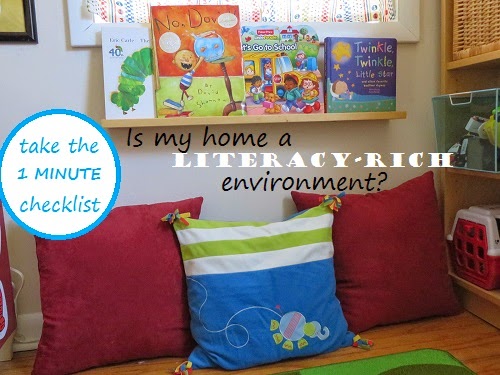
“Children with access to books and to quality reading experiences in their homes have more rapid language & literacy development compared with children without such advantages, and they are more able to enter school ready to learn. And although early childhood educational programs can do much to help children develop strong language and literacy skills, there is little substitute for the power of children’s rich, positive, frequent experiences with books with their homes under the sensitive guidance of a parent.”– quote from Shared Storybook Ready: Building Young Children’s Language & Emergent Literacy Skills by Helen K Ezell & Laura M. Justice.
Complete this quick checklist of features of a literacy-rich environment
to help evaluate your home:
___ My home includes a variety of books that are easily accessible to my children (that is, placed on easy to reach bookshelves, or in bins on the floor, etc).___ My home includes a variety of other printed materials (for example, card games, newspapers, magazines, notes, informative labels).___ My home contains writing tools that are easily accessible to my children (for example, pens, pencils, crayons, markers, paper, journals). ___ There are numbers throughout my home that are in my children’s view (on clocks, thermostats, calculators, calendars, money).___ There are areas in my home designated for reading (for example, a comfy chair with a light or a “book nook”).___ There are areas in my home designated for writing (for example, a playroom with a kid sized table, a desk with paper and pencils, or a night stand with a journal).___ The play spaces in my home promote literacy skills (for example, having a cookbook in a child’s kitchen area, or a notepad and pencil with a doctor’s set).___ My children often see the adults in the home engaged in reading and writing activities (for example, reading a magazine or writing a shopping list).___ We have a specific time set aside for reading and writing activities (for example, writing or drawing in a journal before bed, or reading stories before dinner every night).
How do you measure up?
Process art allows children to create, explore, problem solve, and express their feelings in a child-centered environment. With process art, children's creativity can flourish and their creations are as unique as themselves. Engaging children in process art activities is a wonderful opportunity for children to enhance a number of skills including language and early literacy. Today I'm sharing some fun art books that will spark your child's interest in creating his own masterpiece, and I'm offering a few suggestions that will promote their learning.
My daughter's preschool happened to be celebrating art this week, and she learned about famous artists and the techniques they used. She was super eager to learn more on this topic, so we checked out a bunch of art books from our local library. We found several good books, and even a few that were appropriate for baby brother. These books provided a perfect opportunity to not only talk about the different artists and their paintings, but it introduced many new vocabulary words for her such as
canvas, abstract, modern, impressionist, surrealist, contemporary,
sculpture, portrait, landscape (the list goes on).
Great Books About Art for Kids (click on picture to be taken to Amazon)
- MOMA Art Basics for Kids by Phillip Yenawine












- Touch the Art Series by Julie Appel (great for babies and toddlers)















 Speaking of Art: Colorful Quotes by Famous Painters
Speaking of Art: Colorful Quotes by Famous Painters edited by Bob Raczka

 Art for Baby
Art for Baby (great for newborns)


These books about art are wonderful conversation starters, too! Here are a few prompts that you might consider using with your child:
- What do you think this piece of artwork is named and why?
- What technique do you think the artist used?
- What do you think the artist was feeling when he or she created the artwork?
- What do you like/not like about this artwork, and why?
- When you look at this piece of artwork, how does it make you feel?
- If you could meet this artist, what would you want to ask him or her?
- Tell me what you see in this piece of art. Is there any unusual or surprising?
An Example of Process Art
Using our library books as inspiration, I asked my daughter what technique and tools she would like to use to create a piece of unique art. She wanted to paint, so painting it was! She selected white paper, wrapping paper, a plastic spoon, ribbon, chalk, water, and a paper towel to make her masterpiece. Baby brother got in on the action, too! Process art is a neat sensory experience for babies and toddlers.
Our process art space
Painting with ribbon
Painting with wrapping paper
The finished art displayed on the wall with clipboards
Other examples of process art might include: easel painting, bead stringing, drawing with markers or crayons, stamping, sculpting with play dough or clay, or finger painting.
More on Process Art: What is it and how do you do it?
Process art is a way to foster creativity in young children by providing them with an open-ended art activity. With process art there is no "correct" way to create, there are no models to follow, and no step-by-step procedure. The child is given the freedom to explore various materials (sometimes of their choice) to create artwork that is original and all their own!
Process art can be relaxing for many children as they express their feelings and ideas through art.You might consider playing music in the background as your child works. Encourage your child's ideas and offer gentle support if needed, but try to be as "hands off" as possible! Allow your child to explore new ways of using various tools. If your child feels discouraged in any way, reassure him that there's not right or wrong way to create his art.
Your child will hopefully feel a sense of accomplishment through process art. Since there is no example to follow, no patterns to cut out, and no mistakes to make - children often feel successful at the end of a process art session.
Promoting Language and Literacy Skills Using Process Art
For added skill building with process art, consider asking your child if he would like to discuss his artwork.
- What technique did he use?
- What materials worked well and what didn't?
- Did he use any of the materials in a new and interesting way?
- How did he create ______ (e.g., that yellow spot)?
- What name would he give his art?
- Was his art process similar to any famous artists that he learned about in the books?
Often process art uses fine motor skills that help strengthen the muscles used in writing, but you may want to ask your child if he would like to sign his art or add print to it.
Using the books on art that you read together, try reviewing the vocabulary words as you discuss your child's art. For example, point to the word canvas and say, "This is the word canvas that we learned with this book. Did you use a canvas for your artwork? Why not?"
More Art Books
If you are looking for more inspiring books about art, here are a couple lists from Delightful Children's Books blog.
Other posts about Art or Creativity
Be sure to check out a few of my other posts:
Reading with your baby is one of the most important things you can do together! It enhances your child's language skills by being exposed to a variety of words and new vocabulary, it helps you to bond with your baby, and it builds a foundation of literacy skills that can influence his success as a reader. Today I'm sharing my best tips for reading with your baby along with 25 of my favorite books for the littlest learners. Any (or all) of these books would be a great addition to a home library or gift for someone expecting.
Read Aloud Tips with Babies
- Consider buying cloth books or "board" books. Books that you begin reading early in your child's life will undoubtedly become some of his favorites that you will be reading over and over, and they will need to last awhile. Plus, once he learns how to reach for books and handle them on his own, they will become his favorite snack.
- Select books that have bright, high contrast colors, or interesting photographs (especially of faces) – all of which babies enjoy looking at.
- Be sensitive to your baby’s cues. If he starts to cry, that may mean that he's not into story time, even though you are. If he looks away, it may be a cue that he's being overstimulated. Try to understand his needs and respond appropriately.
- Read and repeat! Children enjoy and learn through repetition and it helps boost memory, so don’t be afraid to read the same books over and over again.
- Choose books or poetry that have a nice rhythm, or rhyme – which help to bring a baby’s attention to the different sounds in words.
- Make reading fun and enjoyable by cuddling, making facial expressions, and varying your intonation. A love of reading is built on pleasurable experiences!
25 Great Books for Reading to Your Baby
Snow, snow, and more snow! Winter hit us hard this year - with lots of snowy days, cold temperatures, and days off from school. Today I'm sharing a few great books that capture the beauty and sentiment of a snowy day. If you are stuck indoors, try our puffy paint activity to make your own snow scene. It's almost as fun as playing in the real snow, and at least you don't have to get all bundled up to enjoy it!
Snow by Steve Sanfield and Jeanette Winter
This book perfectly describes the sights, sounds, and feelings of a snow covered day as a boy explores the first snowfall of the season. The beauty of the text and pictures will make you long for a snowy walk outside to experience this world first hand.
Snow Day by Lynn Plourde and illustrated by Hideko Takahashi

Two children awaken to find "white, glorious white...EVERYWHERE!" This story captures the excitement of snow day activities - a yummy breakfast, indoor games, cuddling by the fire, eating snow day snacks, and playing outside. Children can easily identify with the snow day routine, and will anxiously await their next day of winter fun.
A list of books about snowy days would not be complete without this classic by Ezra Jack Keats. Follow Peter as he experiences the merriment of discovering a snow covered world. What will he do? What will he see? This book is well known for its artwork, and received a Caldecott Medal in 1963.
Written in 1947, this book and its illustrations have an "old-timey" feel. The story follows a postman, a farmer, the policeman and his wife, some rabbits, and children as they prepare for and experience the snowfall. White Snow Bright Snow mixes narrative with poetic text; and coupled with the illustrations (also Caldecott Award winning) that seem to take you back to a simpler time in life, this book is sure to be a hit in your household this winter.
The whole city is gray, and then....a snowflake. An excited little boy exclaims, "It's snowing". We've all felt the joy of seeing one little snowflake transform life from "gray" to a snow covered dream-like winter world. Snow captures that amazing moment simply, yet perfectly, and it will capture your heart.
Puffy Paint "Snow" Craft
If you are looking for a fun inside activity to try on your next snow day, create your own winter scenes like in the stories you've read! This puffy paint craft only uses a few materials and creates a really fun fluffy 3-D substance that you can use to sculpt an indoor "snow" creation.
1) Gather your materials: shaving cream, glue, paint brushes or sponge brushes, construction paper, and any additional decorations you may want.
2) Mix equal parts of the shaving cream & glue. You can add paint or food coloring if you don't want white puffy paint.
3) Create your design! It works best if you "glob" it on.
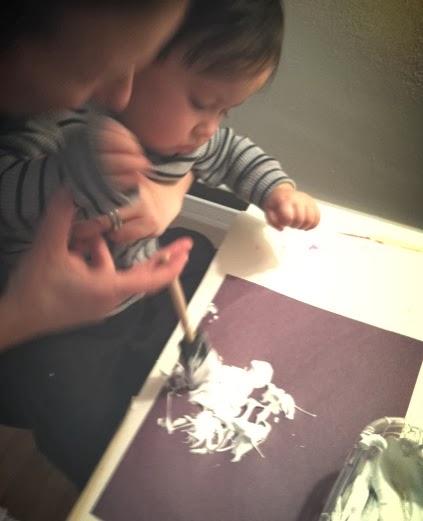 |
I did this activity with my youngest with close supervision.
You'll want to do the same if your little one is still into "eating" things.
|
4) Add decorations. Let your creation dry & admire!
 |
My 4 year old added glitter to hers to make it an "ice storm" and
the stars and letters (constellations) made it an ice storm at night!
I had to join in the fun, and created a snowman. |
Hopefully these books and this activity will make your snow days this winter a little warmer!
Children's picture books and literature are a wonderful way to teach your child about cultural diversity. By selecting texts with characters from different ethnic backgrounds as your own child, you can make text-to-self connections that help him understand that people from other cultures may be different, yet similar in many ways. Recently we read Anna Hibiscus' Song by Atinuke and Lauren Tobias and engaged in a few activities that helped to promote cultural awareness.
Book bonding, or the act of making connections to oneself as a book is read, is an important learning technique that you can use to help your child gain an appreciation and understanding of different cultural backgrounds. By using a multicultural text, your child can experience a world far from their own and get a glimpse of how life is for people with another ethnic heritage. It might be vastly different from your child's own life - the language, the food, the color of the character's skin - and yet, through these books your child will learn that while there are many differences, people from all over the world share many common experiences. They go to school, feel happy or sad, get in arguments with people, or even get in trouble.
Book bonding with Anna Hibiscus' SongWe tried book bonding this week by reading
Anna Hibiscus' Song.
It's a story about a young girl who lives in Africa. When she sees all of her family from atop of a mango tree, she feels so happy she wants to share her happiness. As she visits each member of her family, she discovers what makes each of them happy and what happiness means to her.
The vibrant colors in the book will excite your child as he learns about Anna and her family in Africa. The universal themes of family, love, and happiness are at its forefront, making it an ideal story for making connections.
Activities to promote cultural awarenessAs we read the book together we made note of similarities and differences between our lives here in America and Anna's in Africa....
"Do we have a mango tree in our yard? Do Anna and her family dress like us? Do you play with your cousins? Do we have chickens to feed? Do you ever feel so happy you could float?"My daughter realized she had much in common with Anna, despite living in another country.
Following the story, we tried these 3 activities:
1) PICTURE WALK. We went on a "picture walk" through the book. Focusing on the pictures only, we make a list of action words to describe what Anna was doing. Then, my daughter decided whether the actions were "like me" or "not like me" and I recorded her answers.
2) DRAW A PICTURE. We drew a picture using the prompt: "What makes you feel HAPPY just like Anna does?"
Playing with daddy makes my daughter feel so happy she could float!
3). I AM ANNA. To do this activity we made glasses. But not just any glasses. They were magical glasses (made from paper) that transformed my daughter into Anna. We decorated them in a way that represented Anna (she put flowers on hers and colored it pinkish purple, just like the dress Anna wears in the story). Then I interviewed my daughter as if she were Anna with questions like...
"Anna, what do you like to do?" or "Who do you like to play with?" or "What makes you happy?"
Decorating a pair of glasses in a way that reminded her of the main character.
Then I cut them out and attached string so she could wear them as
we did the activity.
(Please note that this activity would likely be difficult with children under the age of 3 or 4)
I hope you will pick up a copy of Anna Hibiscus' Song from
Usborne Books and try these fun learning activities too. We loved reading and learning from Anna and her family in Africa!
Disclosure: I received a free copy of this book from Kimberly Beavers, an independent consultant with Usborne Books. I'm so glad we got the chance to review it!
Cold weather and cabin fever got you down? Check out Bryn Mawr's newest learning adventure - The Play Café where you can enjoy a cup a coffee, mingle with other caregivers and their young children, and most importantly - PLAY.
We had the pleasure of checking out The Play Café recently, and my 3 year old and infant had a blast. From a really cool Lego loft, to dress up clothes of every kind, to blocks, cars, and small manipulatives for learning, to books, a dollhouse, and an infant climbing area to boot - this place has it all to keep your little ones entertained for hours.
We will definitely be headed back to The Play Café all winter long. Not because the coffee was good (which it was), or because we met some fun playmates (which we did), or because the kids played for hours and didn't want to leave (which was true). No, we'll be back because it's SO important for children to engaged in ACTIVE learning, which The Play Café has plenty of.
Did you know that physical activity activates the brain in ways that promote cognitive development? Children should be encouraged to explore the world with their senses - making learning not only "come alive" but more meaningful, and of course, fun and long lasting! To learn more about the benefits of active learning and play check out these articles: In Defense of Active Learning and Flash Cards or Finger Paints: Should Academics or Play be the Goal of Preschool?
Here are some of the ways we learned through play on our visit:

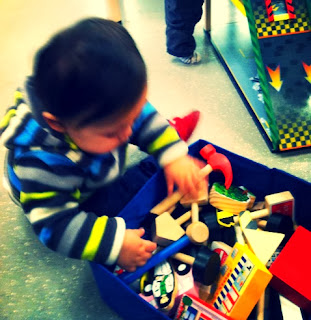
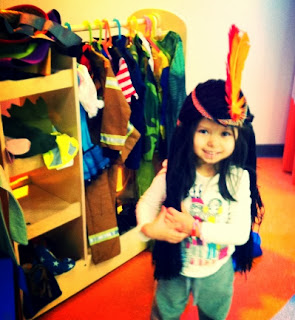
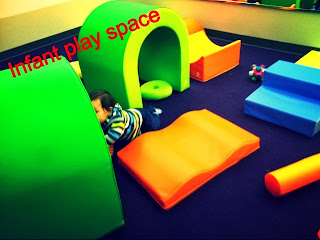
If you are interested in joining in the fun and learning, check out their website
www.theplaycafe.com! In addition to their play space and cafe, you can
register for classes in a bunch of learning areas. If you are around this weekend, visit them for their Grand Opening on January 4th from 9 - 12 - enjoy free admission as well as games, music, and other treats and surprises!
Need a book to go along with your trip to The Play Café? We loved reading
HAVE FUN MOLLY LOU MELON by Patty Lovell. It's the perfect reminder that play and imagination are the best way to learn and have fun!
Make connections to a child's life and personal experiences with a book, and a world of learning emerges. This post shows how we used the new book Larry Gets Lost in Philadelphia by Michael Mullin and John Skewes as a way to experience our nearby city in a new light and learn a little more about why we love it.
 Larry Gets Lost in Philadelphia
Larry Gets Lost in Philadelphia is a book that is perfect for introducing a young child to the beauty, and of course, the history of the city of brotherly love in a fun, kid-friendly way. Children go on an adventure through Philadelphia with Larry, a cute dog who manages to end up lost in a strange city! As he tries to find his way back to his owner Pete, children will enjoy seeing site after site through his eyes.
What makes this book a great learning experience is that it presents historical facts to children in an inviting way, and the vivid and colorful illustrations really make the learning experience come alive!
If you really want to accelerate your child's learning and comprehension with this book, try a few of these strategies that we used:
1. List the places in the book you have visited. We went through the story and identified the places we have been before like the Liberty Bell, art museum, and zoo. We talked about the things that we saw and did there, and also discussed what new fact we learned from the book about that place.
2. Pull out old photos or videos you may have of you visiting the city. We took a trip down memory lane by viewing and reminiscing about our previous tours of Philadelphia.
3. Make a list or draw a picture of the places you would like to visit and why. We decided we'd really love to get to the Barnes Foundation because art is one of my daughter's favorite things to do and learn about.
If you haven't yet visited Philadelphia, but are planning a trip soon - read this book beforehand! Then, as you tour the city refer back to the book. By reading this book in advance, your child will have a knowledge base for him to relate his new experiences to.
Of course these learning strategies can be applied to any of the books in the LARRY GETS LOST series. Check out
Sasquatchbooks.com to see if there is one for your city!
Disclosure: We received a free copy of this book from Sasquatch Books, but our learning is real and our opinions are honest!
Every kid loves to play with pots and pans, right? It's one of the easiest ways to entertain little ones for hours. Today I am sharing a great book by Anne Rockwell that pairs quite nicely with kitchen play, and I have a few ideas for sneaking in some concept learning.
Pots and Pans by Anne Rockwell and illustrated by Lizzy Rockwell shows just how fun playing in the kitchen can be. In this book, two little children have a blast discovering how to use kitchen utensils in a playful way. The simplicity of the text makes it a good read for children ages 3 and under, and the bright pictures are sure to capture their attention.
Read the book, and then play - right in the middle of the kitchen floor with just about everything mentioned in the story! Free play is always a good way to witness the unique and creative ideas your children have. My 3-year old used a spatula to pick up the lids, and then bang them together - which was a way to play that I wouldn't have thought of!
If you would like to try kitchen play in a more structured environment, here are some suggestions:
1.
Play "kitchen band". Make music by banging two lids together, or drumming on the back of a pot. Put some music on in the background for added inspiration. What makes the loudest noise? Softest? Highest? Lowest?
2.
Label the kitchen items. Some of the words from the book might be new to your child, so while playing with a colander, for example, ask your child to name the item. If he can't remember, bring the book over to him and use the words and pictures to figure it out; if he is too little to talk, label the item for him.
3.
Make a math lesson. You can sort the kitchen items by use, by color, by size...the possibilities are endless. And don't forget to count the items, too. Are there
more pots or pans? How many
all together?
4.
Pretend. Put a pot on your head and pretend it's a hard hat and you are construction workers building a tower out of plastic cups. Pretend you are chefs working in a bakery and are making a fancy wedding cake. Best of all, let your kid take the lead on this one if he can pretend on his own.
5.
Create an obstacle course. Jump (or crawl) over the rolling pin and pots and pans. Zig zag around the lids or spatulas. The course can be as fun as you make it!
This week's book of the week is We're Going on a Ghost Hunt by Susan Pearson and illustrated by S.D. Schindler.
This book is a Halloween-themed take on the popular "
We're Going on a Bear Hunt." Rather than a family searching for a bear, four pajama-wearing children set off in the middle of the night with flashlights in tow to find a ghost! Children will love the sing-songy, chant-like rhythm to the book, as well as the excitement that it stirs up. The illustrations are elaborate and really bring the adventure to life.
To extend your learning, after reading this story:
1.
Reenact it. Pretend that you are going on your own ghost hunt. What's up ahead? How will you get past the obstacle? Pile up a bunch of pillows to represent a tree and crawl over them, or splash, splash, splash in a bucket of water to get across the river - the possibilities are endless. Reenacting the story is a great way to enhance gross motor skills.
2.
Play "ghostbusters" - a hide and find counting game. Create ghost cut outs and hide them all around your house (or outside). Then, play the song "GhostBusters" as your child races to see how many he can find. Don't forget to count them as you go along. Who found
more? Who found
less?
3.
Point out the onomatopoeic words - creeeeak - sqeeeak - eeeeeeeeek! If your child can talk, ask him to repeat them, if not, say them to your child - a few in the book are good examples of letter blends in words. What two letters do you hear at the beginning of the word?
4.
Talk about real versus pretend/imaginary. What does it mean for something to be real or imaginary? Make a list of pretend things and those that are real to illustrate the difference.
Sharing this post at:
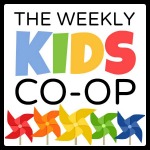
It's apple picking time! Reading books about apples is a fun way to get into the spirit of the Fall season. Pair an apple book with an apple craft for additional skill-building fun that targets your child's fine motor ability in a creative way. This post highlights 3 apple books and crafts that you can mix and match, so choose your favorites and enjoy!
Life Cycle of an Apple,
Picking Apples & Pumpkins, and
The Apple Pie Tree are three apple-themed books that are highly educational. Learn about what is involved in a fun Fall outing by following a family on their trip to an orchard in
Picking Apples and Pumpkins; learn all about the changing seasons in
The Apple Pie Tree; and watch an Apple grow from a bud to a fruit in
Life Cycle of an Apple.
After reading any of these books try:
1.
A sequencing activity. Put the events of the book in order. What comes first, next and last - the seed, a blossom, or the tree? Picking the apples or baking the pie? These books are also a great opportunity to talk about the words
before and
after.
2.
Taking a trip to an apple orchard. Relate your experience to the book you read. Point out some of the new vocabulary you learned from the book.
3.
Creating an apple craft. Practice additional skills and concepts by creating an apple craft. It's the perfect way to talk about colors, shapes, size while practicing fine motor skills in a creative way.
Here are 3 apple crafts that we created!
Mosaic Apple Sun Catcher
A craft that can be done with infants through preschoolers, all you need is red and brown construction paper, colored tissue paper ripped into small pieces, sticky (or contact) paper, scissors, and a green pipe cleaner.
Cut out the contact paper and red construction paper into the shape of an apple. Let the child decorate the contact paper with the ripped tissue pieces, then cover with a second piece of contact paper and trim it to the shape of the apple. Add a stem and leaf as a finishing touch.
Glittery Green Apples
You'll need a small plastic bag, blue and yellow paint, a green pipe cleaner, thick white paper cut into the shape of an apple, glitter, glue, and a plastic container with a lid.
Put a few drops of the blue and yellow paints into the bag, and let your child mix them up to make green (note: please supervise small children when doing this craft).
Place the apple cut out into the bag, and "paint" the apple by playing with it some more!
Let the apple dry.
Grab the plastic container and place the dried apple into it and squeeze the glue on top of it. Add glitter to the container and then place the lid on it.
Last but not least, play some more! Toss the container about and shake it up. When you open it up, you'll have your glittery green apple! Just add a stem and admire.
Red Apples in a Tree
Grab a paper plate, brown construction paper cut into a tree trunk, glue, scissors, green paint and red finger paint, a small sponge, and a round cake pan.
Squirt the green paint into the cake pan, and use the sponge to "paint" the entire pan.
Place the paper plate, white side down, into the pan to make a print. Remove the plate and let it dry. Once dry cut off the rim of the plate.
Using the red finger paint, create apples with the tip of the index finger.
Finally, glue on your trunk to finish the piece.
Can't get enough apple stuff? Check out
20 Apple and Tree Activities for Kids from The Weekly Kids Co-Op 
The Little Yellow Leaf by Carin Berger is this week's book of the week.
An almost melancholy, yet comforting and powerful story of one little yellow leaf. Alone. On a branch waiting to let go and soar into the autumn wind. The leaf is not only lonely, but afraid. Find out what helps the little yellow leaf to overcome his fear and embrace what lies ahead.
This book is a symbolic tale that teaches children many important lessons: even when we seem alone, we are often not; sometimes the unknown can be scary; it can take some people longer "to be ready" for what lies ahead; a friend can make a journey more fun.
The language in
The Little Yellow Leaf is poetic and full of rich vocabulary. The pictures are crafted in vivid, warm, autumnal hues. Don't be at all surprised if at the end of the book, you and your child say to yourself, "wow, that was beautiful".
After reading
The Little Yellow Leaf, try the following to extend your learning:
1.
Talk about the themes. There are some themes in this book that may actually elicit a sadness from your child at the end of the story. Talk about these important themes and feelings.
2.
Discuss any new vocabulary. This book is full of vocabulary that is likely to stretch your child's ability to figure out meaning, so take the time to talk about any words that are unfamiliar and discuss what they mean.
3.
Relate the book to your child. Making connections from text to self is a wonderful way to aid a child's comprehension. Ask your child, "When have you ever been afraid?" or "Describe someone or something that helped you get through a scary moment?"
It's not easy juggling more than one kid. It can be especially difficult to read to multiple children at the same time when they are at different levels of development and have different interests. So how can you make a read aloud fun and beneficial to several children at the same time? This post offers tips for parents or caregivers who have may not have the luxury of conducting a one-on-one shared reading experience.
One of the challenges that I have faced as a mother of a three year old and a baby is keeping
both of my children occupied/entertained at the same time. It is quite literally a daily occurrence that I'm out with both kids and a stranger exclaims to me, "It looks like you've really got your hands full!"
As the months pass, though, I think I'm becoming better at being a mom of two, and I'm learning a few tricks to avoid meltdowns in the supermarket line and for handling two kids on the playground. With respect to all of the reading we do in our house, I'll admit that it has been more difficult to read to both kids at the same time than I thought it would be. The board books are "too easy" for my 3-year old, and she's read them a million times, yet my 8-month old rips her "big kid" books to shreds and can't sit still past the first page, not to mention that he can't sit still at all.
But, I'm learning how to manage read alouds with both children too, and I keep in mind that while reading to children of different ability levels can be a little challenging sometimes, it's also beneficial to learning. The child who is less advanced will learn from the interactions with the more advanced child, and the more advanced child will learn through repetition of concepts that he may have been exposed to already.
Below are 5 tips that I have for making the most of reading to two or more kids at once.
1.
Elicit the older child's help. If you are reading a book that's "easy" for your older child, give him a little challenge by handing him the role of "reader" or "teacher". This tip works especially well if your older child has books that he knows from memory, or can even read a little. If your older child isn't that advanced, try asking him to turn the pages when it's time, or pointing out things in the pictures to make it interesting for him and feel like a helper.
2.
Make it fun. Find books that are interesting for both kids. Flap books are always a big hit, as are pop-up books. You could even try to make up a game as you read the story (e.g., see who can find the most yellow things in the book), or have one child act out the story while the other one watches.
3.
Take turns. As you read the book, ask your older child a question that is appropriate for his ability level (e.g., "What do you think is going to happen next?"); next, in turn, point out something in the story for your younger child, or ask another developmentally-appropriate question (e.g., "what color is the fire truck?"). This is a great opportunity to teach your children about turn taking, and both children will benefit from hearing the interaction with the other child. This technique also helps to sneak in a little one-on-one attention for each child.
4.
Use a high chair or stroller, if needed. If you have a busy body who finds it difficult to sit during a read aloud or who is very fond of ripping pages and eating books, don't be afraid to use a high chair or stroller while you read a short book every once in awhile. It provides you with the opportunity to read a greater variety of books to both children, and it helps to keep both children focused on you and the shared reading experience.
5.
Think simple, classic, and universal. There are some topics (like sharing) and concepts (like the ABCs, counting, shapes, and colors) that never go out of style and can be taught to a wide variety of ages. Books such as these are perfect for reading to a group of young children of different ages.
If all else fails, read to one child while the other does a quiet activity close by. If he becomes interested in the story, he will likely join you.
Reading to more than one child at the same time can be a little more challenging than a one-on-one shared reading experience. Keep these tips in mind to help boost learning and make it a fun environment for everyone, including you!
Babies use their senses to learn about the world around them. By providing your child with the freedom to explore within the constraints of an intentional play activity, you are teaching him concepts and skills without inhibiting his own self-discovery. In today's post I offer you an intentional fall-themed play activity based on a board book that is perfect for babies under 1.
My baby boy bookworm and I spend a lot of time playing. Play is good for his developing mind because babies learn through exploration by using all of their senses to analyze and experiment with their environment, much like a scientist would.
Often I set a few objects or toys on the floor and allow him to investigate them on his own. Sometimes he bangs them together, or pushes them in a playful way. Sometimes he holds an object in his hand and stares at it intently. Many times toys go into his mouth so he can suck and chew on them. I try to be as "hands off" as possible to allow him to discover his own cause-and-effect relationships.
Sometimes I offer him a more intentional learning environment. I still allow him to explore and play on his own, but the activity that I have chosen has been selected with the
intent of him gaining a particular skill or concept.
Leaves is a board book that I picked up at our local library, and decided to use it as the focus of an intentional play activity. It is a book full of the colors of autumn, photographs of smiling children playing in leaves, and simple language to describe leaves and what fun they can be.
Here are some suggestions for reading this book with your baby:
1. Talk about and point out all of the fall colors in the book
2. Talk about the different kinds of leaves you see in the book
3. Talk about the different sights and sounds of autumn
4. Talk about the children in the book and why they might be dressed they way they are
If your child is an active crawler or walker who doesn't like to sit while reading, take advantage of your high chair or stroller like I often do.
Allow your child to handle the book after you are done reading and talking about it. Point out the words versus the pictures, the title and front cover, and demonstrate how to turn the pages.
Next, invite your child to do a planned play activity that relates to the book. As you do your activity, make connections back to
Leaves and the concepts you might have talked about. Intentional learning activities might include:
- Exploring and playing with leaves at the park, or at home (shown below)
- Finding different kinds of leaves and collecting them while on a walk
- Playing in a fall-inspired sensory bin full of different kinds of leaves
- Painting a leaf cutout using finger paints in fall colors
- Painting "leaves" on a tree with baby food in fall colors (shown below)
While your child plays, allow him to discover and explore on his own but offer guidance. Ask questions or narrate to help boost his language skills. What does the leaf feel like? What is this part of the leaf called? What does the leaf sound like if we crinkle it? What color is this leaf? How many leaves did we find?
I think you'll be surprised at the ways your little scientist baby explores and learns all by himself.
Can't find
Leaves? Check out the touch-and-feel board book
Fall.
View Next 25 Posts



.jpg)












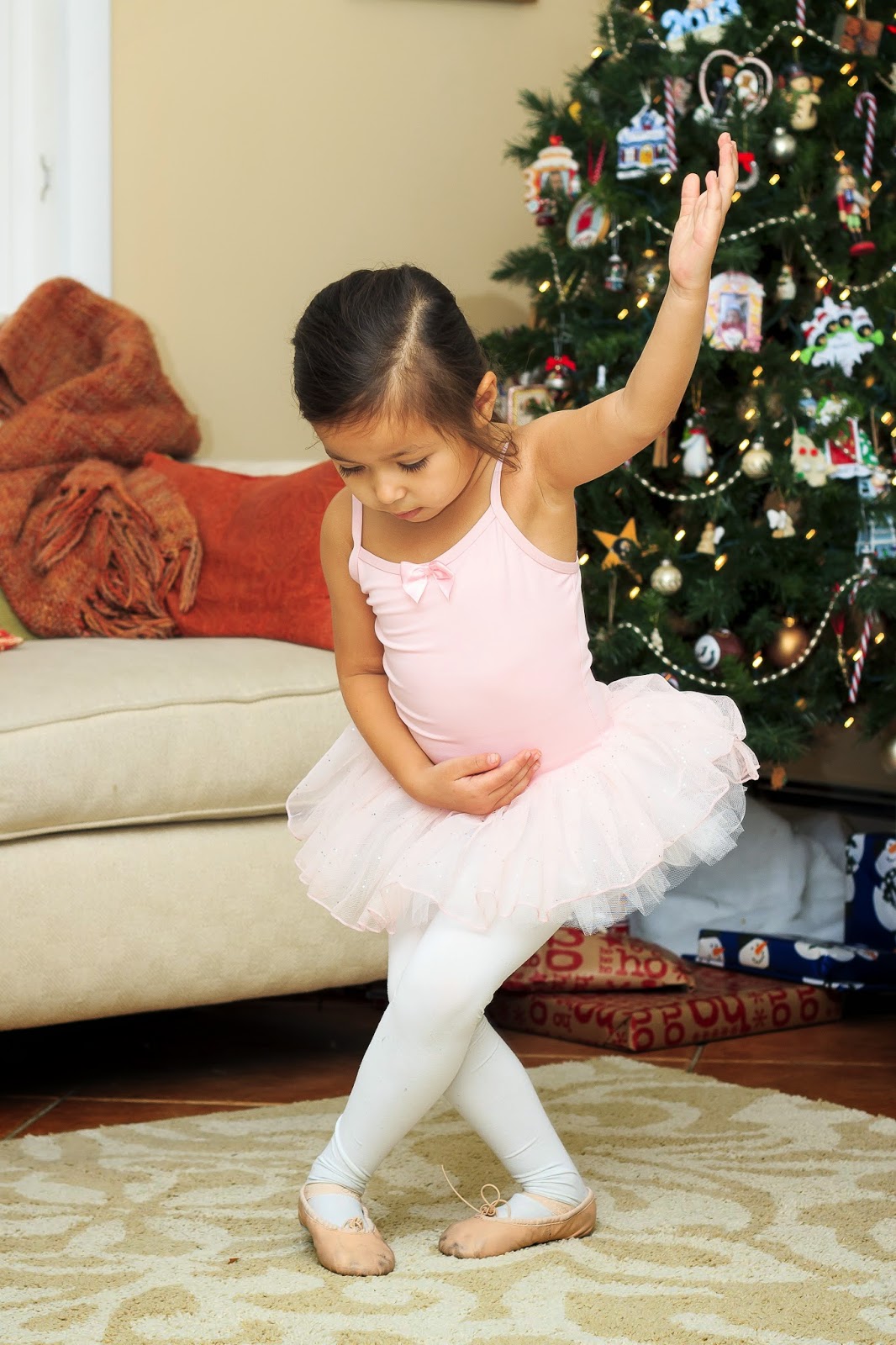
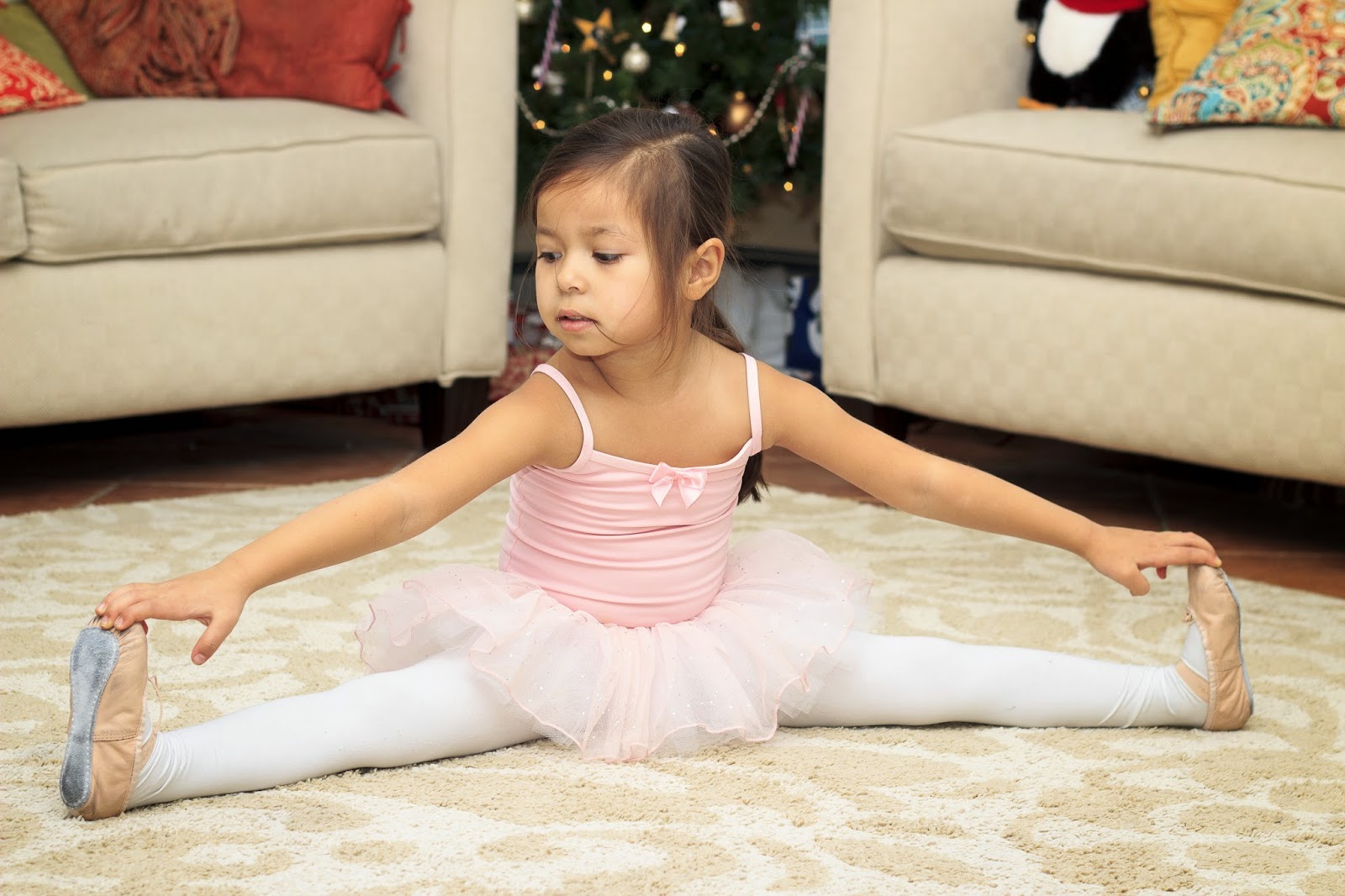
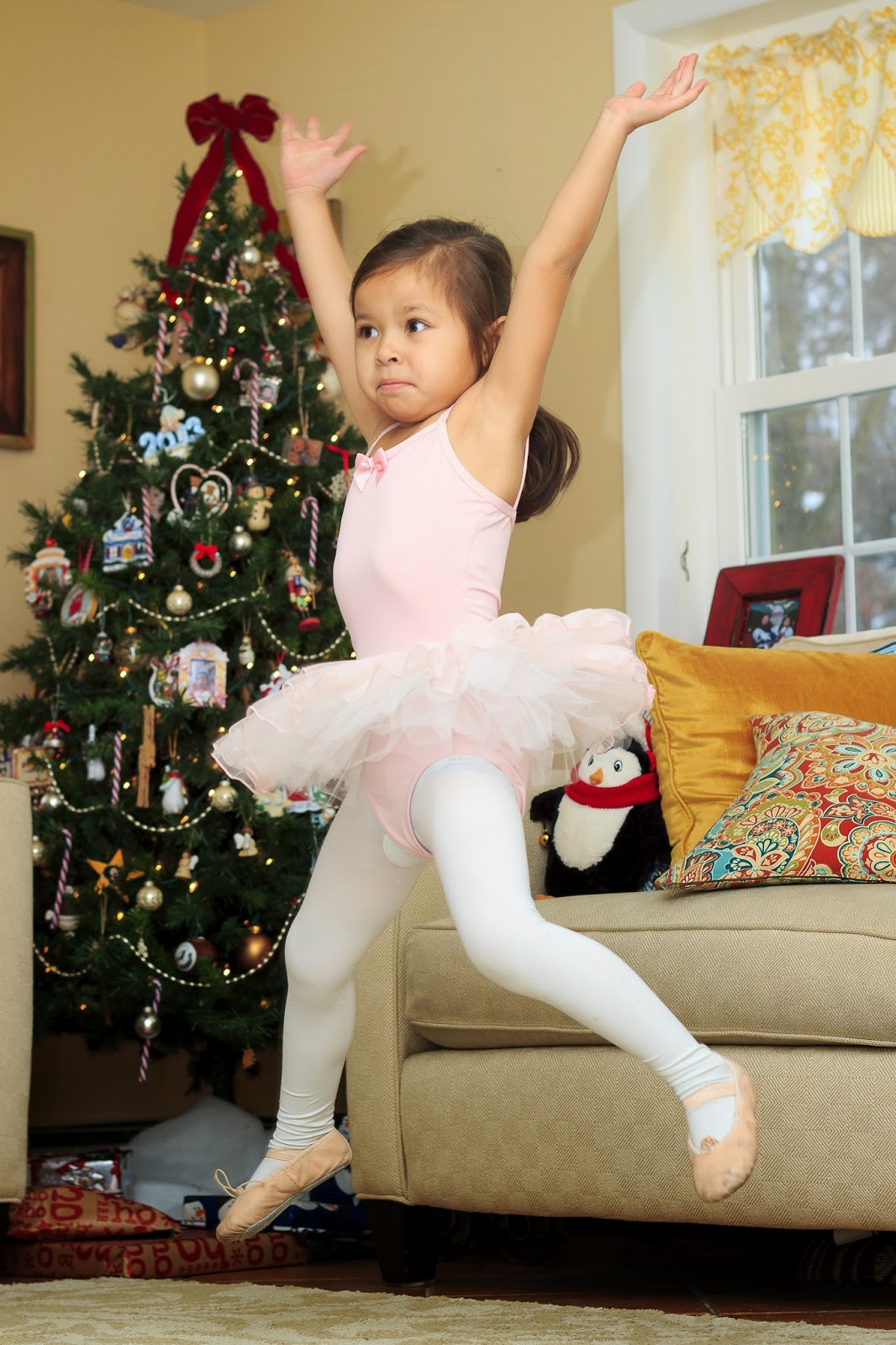
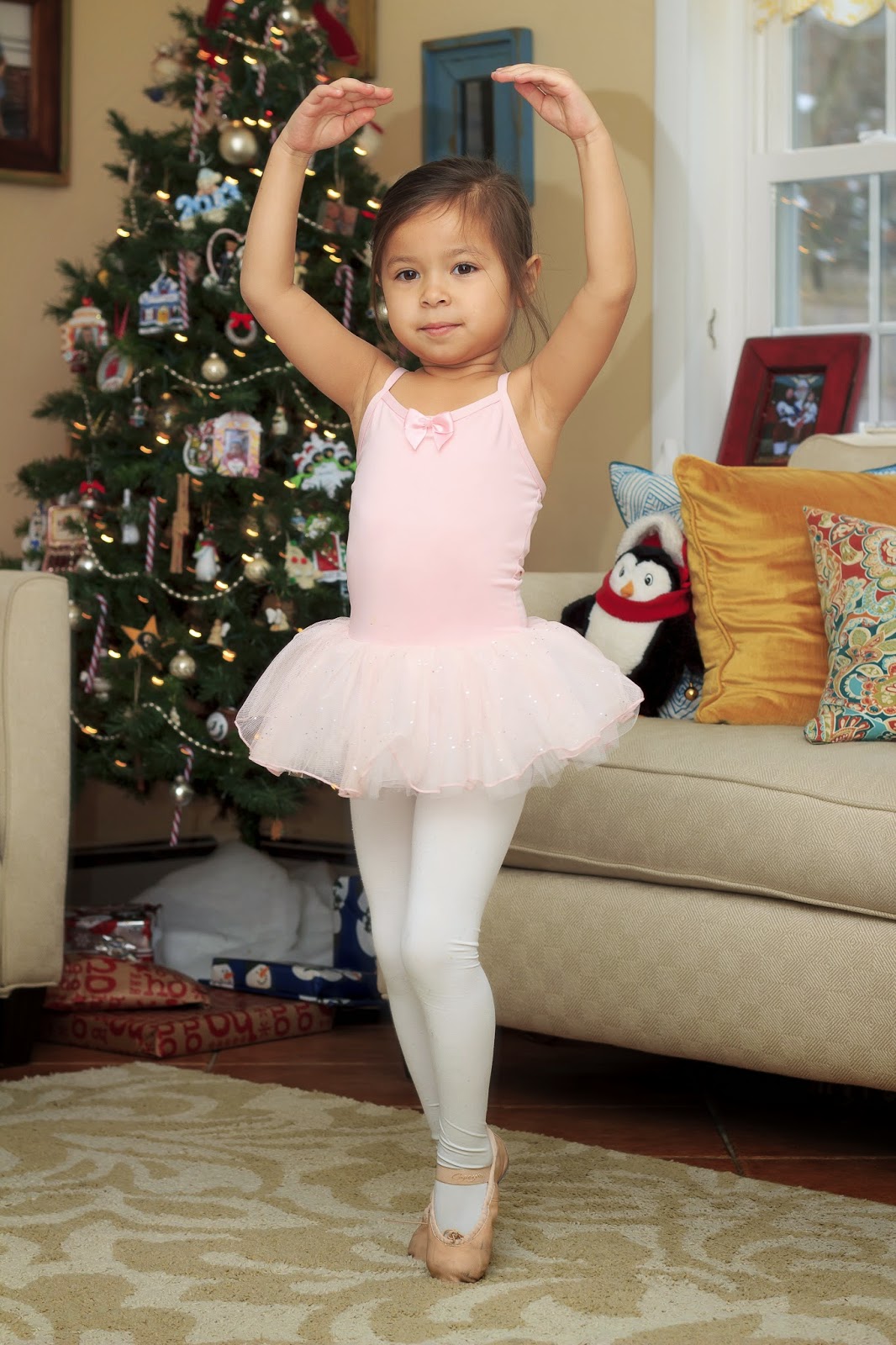










.jpg)











